



You probably reached this "BlogX1" page from another called
BlogX,
Snoopy,
or the
Design page
.
Click on a link to know more.
Each "blog" page describes detailed work preparing for the next Atlantic Attempt.
i.e. covering a period in the region of a year: less if more than one attempt is made.
The Blog pages were started after the first 2012 Attempt, where Snoopy's boat was lost.
The blogs provide online "Engineering Notebooks",
providing a day-by-day account of repairs, changes, and testing: mostly testing.
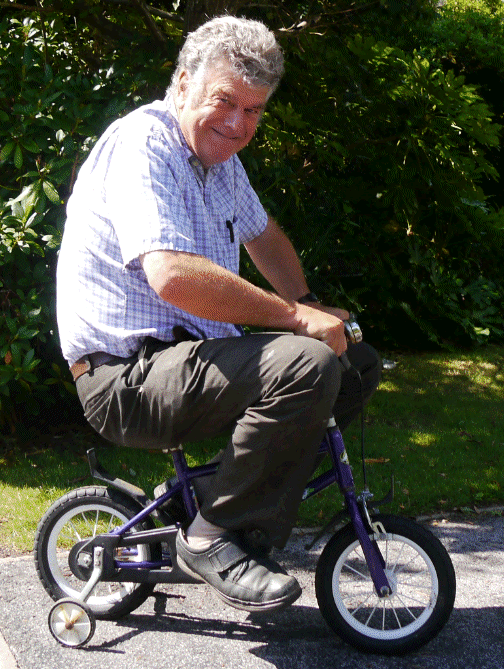
 These blog pages are mostly about numerous repairs to the boat, results from "BRAY LAKE TESTS", or 24/7 reliability testing on Bray Lake:
Snoopy sailing back and forth over a 24/7 waypoint in "Snoopy Corner", typically for several weeks,
in all weather, including gale force winds.
A few things happened which resulted in amusing pictures or stories,
such as countering human-intervention, or testing the wheels for Snoopy's trolly.
Click on the pictures either side for larger versions, or visit earlier blogs above.
This "BlogX1" and
BlogX, the "blogs of experiments", include ideas and products, some of which may appear
in future boats.
These blog pages are mostly about numerous repairs to the boat, results from "BRAY LAKE TESTS", or 24/7 reliability testing on Bray Lake:
Snoopy sailing back and forth over a 24/7 waypoint in "Snoopy Corner", typically for several weeks,
in all weather, including gale force winds.
A few things happened which resulted in amusing pictures or stories,
such as countering human-intervention, or testing the wheels for Snoopy's trolly.
Click on the pictures either side for larger versions, or visit earlier blogs above.
This "BlogX1" and
BlogX, the "blogs of experiments", include ideas and products, some of which may appear
in future boats.
Snoopy's robot boat experiments started in 2008, but it was not until 2012 that we had a boat suitable to make an attempt on the Atlantic. The Design Page was created in late 2012, to document our design, to support building of the next boat. This page soon became a "blog", recording the stages of construction and test. These soon became so big, that they had to be split into different blog pages, each describing the construction, test and repairs, of the next boat to be "thrown into the Atlantic". The latest blog is in the current Blog Page.
We never did have a blog of our experiments, probably because we made so many mistakes, and changed things, much faster than we could document them ! :-) However, my friends and "Team Members" suggested such an "experimental blog" might be of use, so here it is, and we put "experimental stuff" here, rather than in the blogs dedicated to the actual boats being prepared for Atlantic Attempts.
The "Bray Lake Test" has been the same "first challenge", since we started our first experiments in 2008. It took years to achieve success !



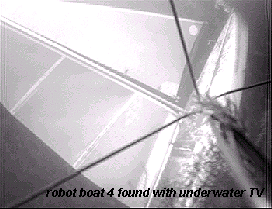 We started with small boats, with the autopilot based on a Pocket PC, controlling a wind vane, which controlled the rudder.
We always knew that electrical power for electronics was a key issue, probably having to be provided by solar panels,
and vane-rudder steering seemed the obvious solution, since the GPS and other electronics, might be switched off for long
periods.
We started with small boats, with the autopilot based on a Pocket PC, controlling a wind vane, which controlled the rudder.
We always knew that electrical power for electronics was a key issue, probably having to be provided by solar panels,
and vane-rudder steering seemed the obvious solution, since the GPS and other electronics, might be switched off for long
periods.
During these early years, we also experimented with different types of boat, starting with small monohulls, such as Boats 1 and 2, then trying others, such as a "sawn off surfboard" (Boat 3) and trimarans - Boat 4, which started as a standard International One Metre (IOM) hull, but was later modified to a trimaran.
In late 2009, we had an interesting diversion, searching for boat 4 with an underwater TV camera ! Video of this, and lots more, is on the 2008 to 2010 Page.
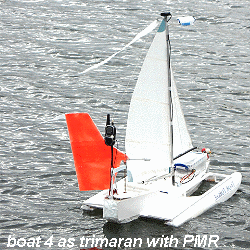 Boat 5 was larger - about 1.2m / 4 feet long, was also changed into a trimaran, and was the first to pass "The Bray Lake Test".
Boat 5 was larger - about 1.2m / 4 feet long, was also changed into a trimaran, and was the first to pass "The Bray Lake Test".
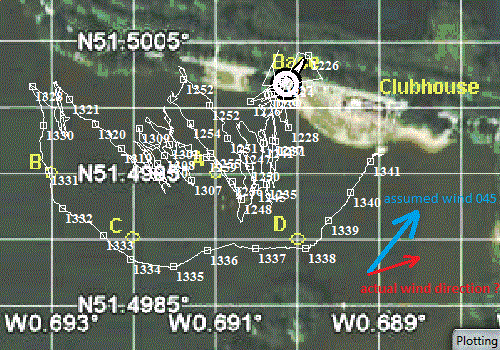 On the right is the GPS Plot of this first Bray Lake Test success, on Friday 13th May 2011 - not so unlucky after all ! :-)
On the right is the GPS Plot of this first Bray Lake Test success, on Friday 13th May 2011 - not so unlucky after all ! :-)
The GPS Plot was recorded by the same GPSSppc for Pocket PC program, used to provide the autopilot, by turning the wind vane, which then steered the boat.
Work then started on trying to make a boat that might be suitable to cross the Atlantic. We soon found that it was difficult to design and make a wind vane based system, that would work in a wide range of wind speeds. e.g. from 5mph to 25mph and more. If the vane were big enough to work in a light wind, our wind vane servo struggled to turn it in a strong wind. Even if that problem were solved, it would be difficult to make the system robust enough, to survive months of continuous use.
We thought of a "wind vane clutch", but did not pursue it, because we were soon having success with the experimental "GPS-only autopilot". This had been suggested by John years earlier: simply using the GPS based direction of movement as an indication of the direction the boat was heading, and for the autopilot to steer the boat in the correct direction, with a rudder servo.
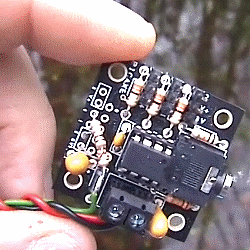 By then we had plenty of GPS plots, and Bray Lake Tests, where we had heard
the autopilot speaking information such as the GPS-based direction to steer
- even though the steering was done using the vane rudder.
e.g. "steer right 15 degrees".
By then we had plenty of GPS plots, and Bray Lake Tests, where we had heard
the autopilot speaking information such as the GPS-based direction to steer
- even though the steering was done using the vane rudder.
e.g. "steer right 15 degrees".
This was also when we decided to try and squeeze the autopilot software into a Picaxe 08M2 computer (on left), and Boat6 was built as the testbed. That's boat 6 having it's first taste of salt water below. The new Picaxe based, GPS-Only autopilot worked well, and we were soon working on Boat 7, then Boat 8, with solar panels, towards a sea-worthy boat, and our first attempt on the Atlantic in late 2012.
More detail of these years is on the 2011 to 2012 Page. It was not until late 2012 that we set up the Design Page and 2013, before we started what are now the Blog1, Blog2, and (current) Blog pages. Practically all the "experimental" work described on these "blog" pages relates to finding and fixing problems with boats preparing to make an Atlantic attempt. This is the new "BlogX" page, started in late 2014, for experimental work.

All our boats, used for 2012, 2013, and 2014 Atlantic Attempts, had the same design: the following section is near the start of our Design Page....
Experimental prototypes first sailed, on Bray Lake, in 2008, but it was not until 2012, that we had settled on the current design, used in all our Atlantic attempts:
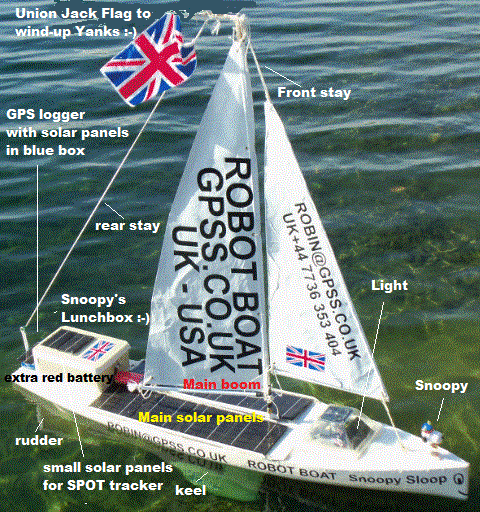
All products used within a boat will have undergone months, sometimes years, of experimental test, before weeks or months of 24/7 test, before an Atlantic attempt. Please do not confuse what we are doing experimentally, for possible use in future boats, with our "current design" above. e.g. experiments with boat 6 to test things like compass-based steering, use of wind direction sensors, etc.
Remember that the biggest challenge to a robot boat crossing the Atlantic is reliability: maybe the most useful thing to remember is "KISS" - Keep it Simple, Stupid :-)
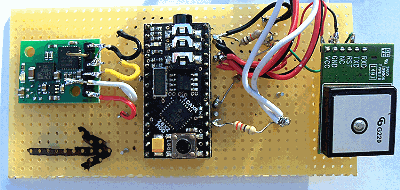 Experimental work started in 2013, on things which might find their way into future boats. e.g. Boat 11 for 2015.
Experimental work started in 2013, on things which might find their way into future boats. e.g. Boat 11 for 2015.
Experiments started with compass-based steering in late 2013, while waiting for our "launch window". Compass-based steering has big potential for reduced power consumption, by switching off the GPS for the majority of the time. The GPS consumes more power than the rest of the electronics. This is why we were originally interested in wind-vane based steering. Our first compass was unsuitable, since it was not tilt-compensated, and needed a mechanical gimbal. The "compass work" is described in detail on the Compass Page, which includes GPS Plots such as that in the lower right.
In 2014 we found a tilt-compensated compass, at a sensible price, and this looks very promising indeed, for use in 2015 - after sufficient development and testing. We also started to use a much more suitable Picaxe computer: the 28X2, instead of the 08M2, and this is mentioned on the Design Page, the "Compass" page above, and Software Page. We already had a solution for a Wind Direction Sensor, from years ago, which had originally been discarded due to increased power consumption. However, with power-switching, this also reduced power consumption to a low level.
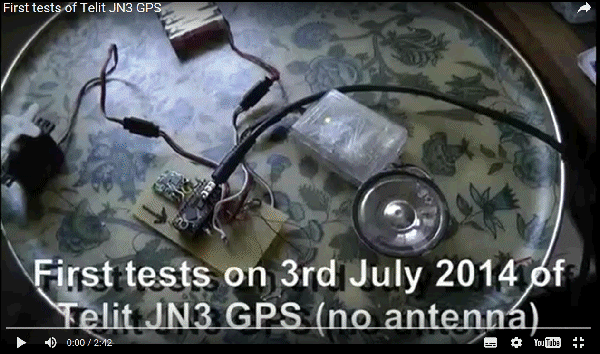
 Click on the left picture to play the video of a "Tea Tray Test" of a Picaxe 28X2 based Autopilot with Compass and Telit JN3 GPS.
Click on the left picture to play the video of a "Tea Tray Test" of a Picaxe 28X2 based Autopilot with Compass and Telit JN3 GPS.
We got the experimental 28X2 based autopilot software to implement smoothed wind direction and tacking. "Jibe" logic was also added, so that the boat would make a turn downwind, if it were unable to turn across the upwind direction. Tacking is only done if the wind direction sensor is present. The software recognises if there is no wind direction sensor, and then simply steers towards the destination - often resulting in "natural tacking" seen in our GPS Plots.
At the time of writing this, in October 2014, it is thought our experimental work in late 2014, into 2015, will concentrate in use of the compass and power switched GPS, avoiding use of the wind direction sensor - which includes the mechanical vane - yet another source of failure in a long sea crossing !
We will need to watch out for more positive compass-based steering, putting the boat "into irons", if the destination is directly upwind. This is avoided by the old "GPS-only" design, by a combination of "boat balance" (mast further forward to give "lee helm") and the steering logic, which includes "rudder trim". If we do have a problem, we can easily emulate the old logic, but even simpler software solutions are probably possible.
See "2014 and the Devantech CMPS10 Tilt Compensated Compass Module" in the Design Page for much more detail on the DMCP10 Tilt-Compensated Compass, and several different GPS products tested in 2014. This "experimental work" as not been moved into the "BlogX" page.
Monday 27th October: the following is based on section "e1. electronic compass ? Bigger computer ? Power switching of sensors ?" in the Design page ...
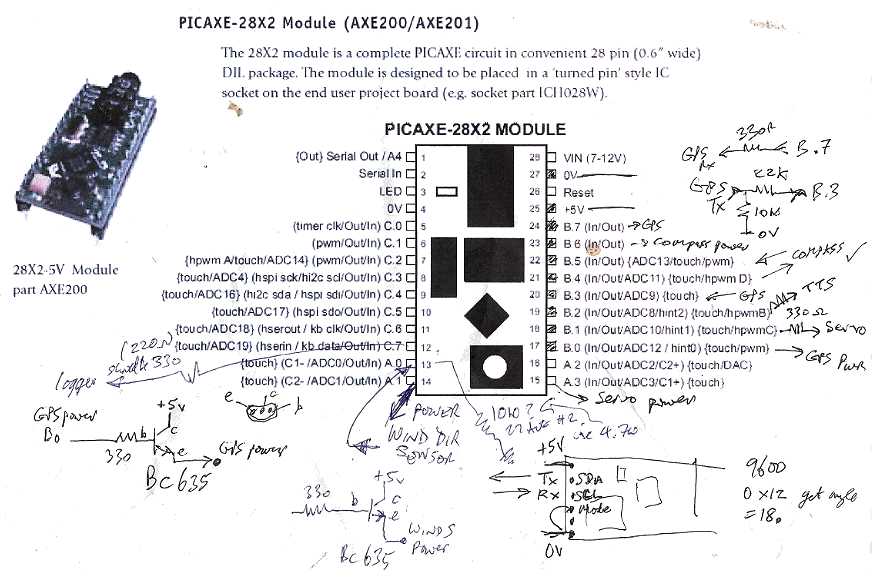 This experimental work is not relevant to the existing design, used in boats 8, 9 and 10, but it might be used in future boats.
If you go back to my earliest thoughts in 2008, you will see I was thinking of a flux gate compass, to sense where the boat
is pointing, for the autopilot steering. Our simple GPS solutions use, instead, the direction the boat is moving - which is not
the same thing. Things like the tide can "confuse" the autopilot. We can live with this design limitation, but, if we wanted to perform
a sailing mission such as "sail around the Isle of Wight" - we would need to have an autopilot that would handle the tide better.
However, the main benifit of the compass is probably to allow power switching of the GPS, with the consequent reduction
in power consumption, numbers of solar panels, weight and cost of the boat.
This experimental work is not relevant to the existing design, used in boats 8, 9 and 10, but it might be used in future boats.
If you go back to my earliest thoughts in 2008, you will see I was thinking of a flux gate compass, to sense where the boat
is pointing, for the autopilot steering. Our simple GPS solutions use, instead, the direction the boat is moving - which is not
the same thing. Things like the tide can "confuse" the autopilot. We can live with this design limitation, but, if we wanted to perform
a sailing mission such as "sail around the Isle of Wight" - we would need to have an autopilot that would handle the tide better.
However, the main benifit of the compass is probably to allow power switching of the GPS, with the consequent reduction
in power consumption, numbers of solar panels, weight and cost of the boat.
The rough notes on the right were put here, in case I lost the paper original. Click on it for the bigger version.
I would describe the current experimental work as "research" rather than "development" :-)
Footnote on Saturday 25th October 2014: I started some tests, picking up from work in August. Right now there are three 28X2-Compass autopilots: one in boat 6, one in boat 11, and one on the tea-tray. Only the tea tray autopilot has the GPS and servo power-switching changes. Tests with a milliamp meter confirm that the first two still consume current in the ballpark of 60mA. i.e. switching from a Picaxe 2M2 to the 28X2 does not make a significant increase in power consumption: the Picaxe draws less than 5mA.
After fixing a short between pins 27 and 28, initial tests indicate power consumption in the ballpark of about 20mA when the GPS is off, and the boat is using compass steering, and about 60mA when switching on the GPS for a "navigation check". The better BR355-S4 GPS only seems to need a second or two of power, before it tracks, and is switched off. So, if off for even 30 seconds, the average current for the GPS will drop to less than 10% of it's normal ~40mA.
Most of the 20mA is for the servo, so further reductions might be made by power switching of this - already working back in August 2014. But for now, we will keep it simple, and stick with just compass and GPS power switching.
Looking at the last experimental software change (AUTOPX1.BAS dated 22 Aug 14), it seems, for our first experiments with GPS power switching, the following rules are used: GPS power kept on if within 30m of target; switched off for 10 secs if 30m to 50m; switched off for 30 secs if further than 50m from target. The compass is used for steering when the GPS is switched off. These rules can easily be modified, after we get the power-switched autopilot working as it should. i.e. still doing it's job, tested on Bray Lake, and with significantly less power consumption than the existing 8M2 based systems.
So, in conclusion, far more experimental work is needed, including tests on Bray Lake, but it does look as if power switching of the GPS can reduce the autopilot power consumption by 50% or more. The boat 6 autopilot has been modified to include GPS power switching and the latest Picaxe software. The old BR353 was replaced by the later BR355-S4 and we saw an immediate improvement in the time needed to start tracking, after switch-on: from about 60 seconds (indoors) to nearer 2 seconds ! This will be needed if the GPS switching is to be exploited.
Remember that this is all "background experimental work", while we wait to launch Snoopy in boat10 !
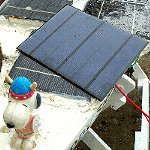 Monday 27th October: following taken from section "e5. Better solar panels ?" on
Design page:
Monday 27th October: following taken from section "e5. Better solar panels ?" on
Design page:
For years, and on all boats used in 2012, 2013, and 2014 Atlantic Attempts, we've used the same 130x130mm
solar panels, purchased via FirstStopSolar in UK, at about £14. Each of the 8 panels, used for the 5v
autopilot supply, measured 130x130mm and delivered a maximum of abot 250mA in direct, bright sunshine.
In 2014 I searched for alternatives, and soon found the bigger one, seen here next to Snoopy.
It was purchased from Shanghai in China, so cost less, at below £7.40. But the important differences
are in the increased power output (583mA), and reduced weight (75gm), without a great increase in size (165x135mm).
I tested these when they arrived, and it looks as if the claimed power output is genuine. I suspect both types of panel originate from Shenzhen in China :-)
The practical result is that fewer panels are needed and the marblehead deck does not need to widened,
to protect the panels. The result should be a lighter, and even less expensive boat.
We expect to test these on Boat 11 in 2014 and 2015, to confirm the panels are reliable
and do not deteriorate with time. The old 130x130mm panels have worked well,
and I hope these new ones will be even better.
The navigation light was originally only included to comply with Microtransat rules. However, when this rule was relaxed, the light was retained, since it was of some help in tracking Snoopy offshore, in the hours after launch. It might also assist finding him, if washed up on a remote stretch of beach. Details are in the Design Page, within the section "3. the 'Navigation' Light sub-system, including solar panels." All lights used in Snoopy's boats have been based on solar powered garden light products.
Thursday 30th October 2014: following is based on some of the Blog2 page, followed by today's test with a Ni-Me cell. Information in Blog2, unrelated to the light, is removed here.
 Friday 21st February: Tests have started in the garden, and I expect first sailing tests on Bray Lake
next week. The picture on left shows three Homebase solar garden light products, with different characteristics,
such as weight, brighness, and ability to stay on all night without modification - such as addition of a solar panel.
We may shorten the rear vertical tube, since the weight and wind-resistance of the lamp are undesirables....
Saturday 22nd February: ...
Friday 21st February: Tests have started in the garden, and I expect first sailing tests on Bray Lake
next week. The picture on left shows three Homebase solar garden light products, with different characteristics,
such as weight, brighness, and ability to stay on all night without modification - such as addition of a solar panel.
We may shorten the rear vertical tube, since the weight and wind-resistance of the lamp are undesirables....
Saturday 22nd February: ...
 I've purchased two more types of solar garden lamp to compare with the three products above,
and found somewhere we might use for range tests...
Sunday 23rd February... three solar lamp products
prepared for range testing, on poles with labels, should they be found. 1. "Bright"; 2 "Soft Glow"; 3 "Super Bright".
See left.
...
Another solar garden light arrived, from ebay, called here "5.dull", and we also have "4.string", a string of 50 LED at £10.
Here, on the right, are all five, switching on shortly after 6pm, and ready for a range test.
I've purchased two more types of solar garden lamp to compare with the three products above,
and found somewhere we might use for range tests...
Sunday 23rd February... three solar lamp products
prepared for range testing, on poles with labels, should they be found. 1. "Bright"; 2 "Soft Glow"; 3 "Super Bright".
See left.
...
Another solar garden light arrived, from ebay, called here "5.dull", and we also have "4.string", a string of 50 LED at £10.
Here, on the right, are all five, switching on shortly after 6pm, and ready for a range test.
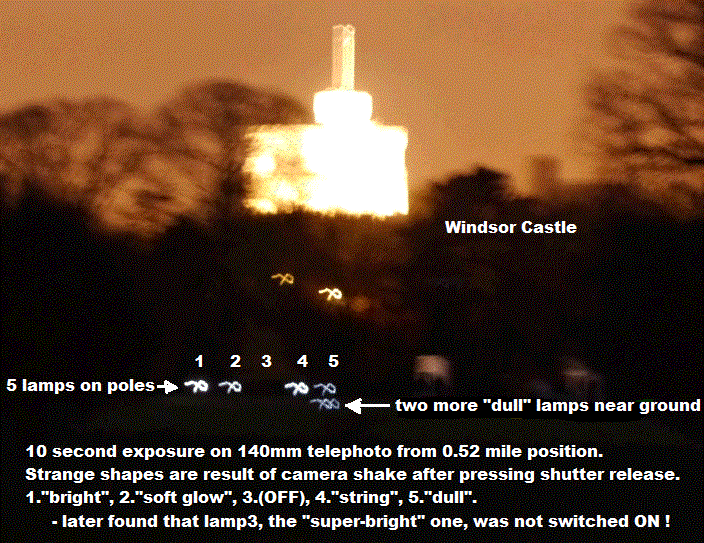 Sunday 2nd March: last night, not long after 6pm, we did our first range tests on the solar garden lights.
Here, on the left, is one of the photos taken from a range of 0.52 mile (830m). At this range the faintest lights were
just visible with the naked eye, and clearly visible with binoculars. We have yet to test the "super-bright"
product. Today I discovered that it's switch was not in the "ON" position ! :-)
This "test range" near Windsor Castle, should enable tests up to two miles - if you don't mind the walking.
Next time we hope to include the "super-bright" product, and I'll use a remote shutter release to avoid camera shake...
Sunday 2nd March: last night, not long after 6pm, we did our first range tests on the solar garden lights.
Here, on the left, is one of the photos taken from a range of 0.52 mile (830m). At this range the faintest lights were
just visible with the naked eye, and clearly visible with binoculars. We have yet to test the "super-bright"
product. Today I discovered that it's switch was not in the "ON" position ! :-)
This "test range" near Windsor Castle, should enable tests up to two miles - if you don't mind the walking.
Next time we hope to include the "super-bright" product, and I'll use a remote shutter release to avoid camera shake...
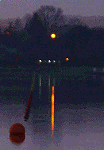 Thursday 6th March: Last night we did another lamp range test, but this time at Dorney Lake, over
a distance of 2.3 km, or 1.43 miles. On the right you can just make out the row of brighter lamps.
The bright orange light is a street lamp on a bridge, and the fainter orange light is probably another, on a distant road.
The brightest lamps were just visible by naked eye and easily seen with binoculars. Dick pointed out how
significant the orientation of the LEDs were: these standard garden lights tend to point the LEDs down
to illuminate the path. This was shown dramatically when we twisted the single "dull" LED, to point down
the lake, and it was almost as bright as the brightest lamps. Conclusion: modify the orientation of the LEDs
or make up a suitable assembly from scratch. The boat will pitch and roll, but at least the average beam directions
should be horizontal, and not pointing down, unless onto a suitable reflector.
...
Thursday 6th March: Last night we did another lamp range test, but this time at Dorney Lake, over
a distance of 2.3 km, or 1.43 miles. On the right you can just make out the row of brighter lamps.
The bright orange light is a street lamp on a bridge, and the fainter orange light is probably another, on a distant road.
The brightest lamps were just visible by naked eye and easily seen with binoculars. Dick pointed out how
significant the orientation of the LEDs were: these standard garden lights tend to point the LEDs down
to illuminate the path. This was shown dramatically when we twisted the single "dull" LED, to point down
the lake, and it was almost as bright as the brightest lamps. Conclusion: modify the orientation of the LEDs
or make up a suitable assembly from scratch. The boat will pitch and roll, but at least the average beam directions
should be horizontal, and not pointing down, unless onto a suitable reflector.
...

 Saturday 8th March: ...
The picture on the left shows the solar lamps under test in my front garden, watched by CCTV. The new "6. ultra"
on the right looks promising. It seems a good compromise between brightness vs simplicity, weight (150gm) and cost (£10).
It seems to run all night, if the single AAA 400mAH battery is replaced by a better one. e.g. 600mAH.
It has a fresnel lens and reflector, to give better beam directions from the four LED pointing down.
The "Ultra" lamp was adopted for use on boat 10 - see picture on the right.
Saturday 8th March: ...
The picture on the left shows the solar lamps under test in my front garden, watched by CCTV. The new "6. ultra"
on the right looks promising. It seems a good compromise between brightness vs simplicity, weight (150gm) and cost (£10).
It seems to run all night, if the single AAA 400mAH battery is replaced by a better one. e.g. 600mAH.
It has a fresnel lens and reflector, to give better beam directions from the four LED pointing down.
The "Ultra" lamp was adopted for use on boat 10 - see picture on the right.
Thursday 30th October 2014:
The single 1.2v AAA NiMH cell, used within a spare "Ultra" lamp, was replaced - for experiment
- by a 1.8v AAA NiMe cell, to see if it lasts longer than the 7 hours seen recently
(see today's current
Blog
for
"lamp was swapped for identical £2.50 spare, which CCTV showed staying on longer: 7 hours, in shady garden". )
This use of NiMe cells might be "misuse" - but so was the use of NiMe cells in our SPOT trackers - and they have worked reliably for years !
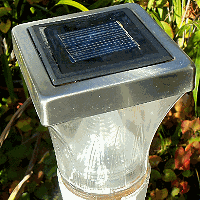 Friday 31st October:
After several "false starts" with flat Ni-Me cells, we got less than 6 hours (9pm->245am)
from the AAA NiMe cell - maybe that was also not fully charged. However, further tests with a meter,
on the Ultra solar lamp, indicated that existing use of a AAA NiMH cell should be fine: the LEDs only draw
about 12.4mA from a NiMH cell at 1.2v, and most AAA cells of this type claim 500 to 1000mAH or more (~50 hours+).
The same LEDs powered from the NiMe cell at 1.8v draw nearer 58.4mA - probably due to protection of the
supplied NiMH cell from overcharging. The small 60x60mm solar panel was seen to supply 45mA in direct, weak sun, at 1030am.
So, in conclusion, there seems no benifit in using larger NiMH cells than AAA, and certainly not NiMe.
To extend the "on" hours of the lamp, from dusk 'til dawn, in our winter, we would do better adding a small solar panel,
as we did to the very first boat in 2012. But remember: this lamp is "optional", and why we have retained it - for now.
Friday 31st October:
After several "false starts" with flat Ni-Me cells, we got less than 6 hours (9pm->245am)
from the AAA NiMe cell - maybe that was also not fully charged. However, further tests with a meter,
on the Ultra solar lamp, indicated that existing use of a AAA NiMH cell should be fine: the LEDs only draw
about 12.4mA from a NiMH cell at 1.2v, and most AAA cells of this type claim 500 to 1000mAH or more (~50 hours+).
The same LEDs powered from the NiMe cell at 1.8v draw nearer 58.4mA - probably due to protection of the
supplied NiMH cell from overcharging. The small 60x60mm solar panel was seen to supply 45mA in direct, weak sun, at 1030am.
So, in conclusion, there seems no benifit in using larger NiMH cells than AAA, and certainly not NiMe.
To extend the "on" hours of the lamp, from dusk 'til dawn, in our winter, we would do better adding a small solar panel,
as we did to the very first boat in 2012. But remember: this lamp is "optional", and why we have retained it - for now.
Further tests resulted in my ordering four slightely larger 2v solar panels, for future experiment, from FirstStopSolar.
The tests, at about 1215, showed that the small panel on the lamp, generates about 67mA s/c in strong sun,
and about 2v o/c. Moving a finger over the surface revealed that the active area of the panel was only 40x40mm,
of the 60x60mm panel. So it seems there is scope to improve performance by simply placing a bigger panel on the top.
The ordered panels cost less than £3.25 each, and measure 65x45mm, claiming 150mA output.
Sunday 2nd November:
after some sun, both lights ran from dusk (5pm) until dawn (630am): 13.5 hours - both on a Maplin 950mA NiMH AAA cell.
 Thursday 6th November:
Experimental "launch planning work" has resulted in a new
Tide Page.
Small solar panels have arrived from FirstStopSolar.
This new "Tide" page could have big implications for
re-calibrating our use of our old TotalTide model,
over the years - including the analysis of what happened in 2012 !
On the simpler topic of our navigation light: it was a quick job for
this simple modification of the Ultra product, which - after tests
- might be applied to those fitted to the boats. The new, larger panel,
was simply fitted over the old panel, but leaving a gap so enough light
gets in, for the old panel to operate it's on/off function.
If this provides enough extra charging, we don't need to position
the new panel differently, to allow power from the old one.
A small hole was drilled near the side of the old panel,
to pass the two wires into the single AAA battery box.
These were soldered, via an isolation diode, to the battery contacts.
Silicon sealant was used to seal the hole and mount the new panel,
using a bit of plastic as a spacer at the opposite end to the wires.
This modified lamp was put back outside, before 1pm, in overcast conditions.
We will see how well it works over the coming days.
Thursday 6th November:
Experimental "launch planning work" has resulted in a new
Tide Page.
Small solar panels have arrived from FirstStopSolar.
This new "Tide" page could have big implications for
re-calibrating our use of our old TotalTide model,
over the years - including the analysis of what happened in 2012 !
On the simpler topic of our navigation light: it was a quick job for
this simple modification of the Ultra product, which - after tests
- might be applied to those fitted to the boats. The new, larger panel,
was simply fitted over the old panel, but leaving a gap so enough light
gets in, for the old panel to operate it's on/off function.
If this provides enough extra charging, we don't need to position
the new panel differently, to allow power from the old one.
A small hole was drilled near the side of the old panel,
to pass the two wires into the single AAA battery box.
These were soldered, via an isolation diode, to the battery contacts.
Silicon sealant was used to seal the hole and mount the new panel,
using a bit of plastic as a spacer at the opposite end to the wires.
This modified lamp was put back outside, before 1pm, in overcast conditions.
We will see how well it works over the coming days.
Saturday 8th November: New TotalTide received and installed. Seems to give identical predictions as the old 2001 copy ! :-)
The "Tide Page" above updated. Also received another I-GotU purchased off ebay, for Boat 11.
Monday 10th November:
I-GotU tested, and seems to work well enough. Set to normal 12 minutes and put on charge, ready for boat 11.
Both Ultra lamp on boat 10, and modified Ultra (UltraM), failed to stay on for more than about 3 or 4 hours,
last night, despite several hours of sun yesterday. Maybe the AAA NiMH cells had been damaged by over-discharge ?
Both were changed for new ones at 0900, raising volts from 0.75 to 1.25v. There seemed a poor contact on UltraM.
Some more sun today, so we will see how they do.
Tuesday 11th November:
The unmodified Ultra light on the boat remained on until about an hour before dusk, giving over 13 hours.
The modified light lasted less, going out by 5am. Tests will continue.
This morning I started the difficult modification to a spare SPOT Messenger 1 tracker, which will be
needed for Boat 11, next year, assuming that Boat 10 with it's SPOT is eventually lost. The SPOT tracker in Boat 10
has been running continuously, reporting position every hour, for years: it has survived since it
was put into boat 9, after the 2012 attempt. This includes two landings on the Isle of Wight.
The detail of the modification is on our
Design Page in the section
"7.4. Modification of SPOT [OK] switch - to send position reports.".
![SPOT tracker power and [OK] switch contacts](rbdessp2.gif) The picture on the left is from that page, which includes these words:
QUOTE:
Note that it is EXTREMELY difficult to solder the 10k resistor into the SPOT board because everything is so small,
including how close the printed circuit track is to the ground plane. Make sure this is a clean connection,
with no short to the ground plane or elsewhere.
UNQUOTE.
How True ! Before heating up the small soldering iron, I did a couple of manual test transmissions,
by pressing the [OK] switch, then watching the
SPOT Page for spare tracker.
After re-assembing the SPOT tracker, the [OK] button did not start a manual transmission
- but the [Help] button did - so the tracker was still functional.
I got the tracker working as it should, with a spare Picaxe loaded with TIMESPOTH.BAS based on TIMESPOTG from 22Oct13,
but with delay AFTER the transmission - for test.
The picture on the left is from that page, which includes these words:
QUOTE:
Note that it is EXTREMELY difficult to solder the 10k resistor into the SPOT board because everything is so small,
including how close the printed circuit track is to the ground plane. Make sure this is a clean connection,
with no short to the ground plane or elsewhere.
UNQUOTE.
How True ! Before heating up the small soldering iron, I did a couple of manual test transmissions,
by pressing the [OK] switch, then watching the
SPOT Page for spare tracker.
After re-assembing the SPOT tracker, the [OK] button did not start a manual transmission
- but the [Help] button did - so the tracker was still functional.
I got the tracker working as it should, with a spare Picaxe loaded with TIMESPOTH.BAS based on TIMESPOTG from 22Oct13,
but with delay AFTER the transmission - for test.
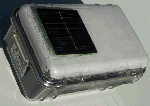 Everything was put in the waterproof SPOT test box (on right), initially without
the two internal AA NiMe cells - only the external 3 x AA NiMH. These were at over 4v - but nothing blew !
By 5pm I had connected the solar panel and put in the two NiMe cells - after charging each to ~ 1.84v.
The external 3 x NiMH battery was 3.99v when both connected - resulting in 3.97v.
We will see if it runs OK, reporting positions every hour, a few minutes after each hour.
It should not then take too long to adjust the software timer, to be accurate to within a minute each day.
After the re-start at 5pm, the first SPOT report was 5:07.
That [OK] button can wait, since it is only used for test.
Everything was put in the waterproof SPOT test box (on right), initially without
the two internal AA NiMe cells - only the external 3 x AA NiMH. These were at over 4v - but nothing blew !
By 5pm I had connected the solar panel and put in the two NiMe cells - after charging each to ~ 1.84v.
The external 3 x NiMH battery was 3.99v when both connected - resulting in 3.97v.
We will see if it runs OK, reporting positions every hour, a few minutes after each hour.
It should not then take too long to adjust the software timer, to be accurate to within a minute each day.
After the re-start at 5pm, the first SPOT report was 5:07.
That [OK] button can wait, since it is only used for test.
Wednesday 12th November:
The Picaxe SPOT timer software, TIMESPOTH.BAS was modified, to add 9.5 sec to the hour delay, after the test
from 6pm until 9am showed it gaining 2M25S. This is matching the software to component tolerances on the Picaxe board.
The spare SPOT was re-started at exactly 0930, and so reports are expected a few minutes after half past the hour. e.g. 0939.
Remember, after the timer "presses" the [OK] button, it takes several minutes for the SPOT GPS to start tracking,
then for a position report to be relayed between the SPOT satellites and over the Net. The time of report will
normally be only a minute or two late, but it will not be received until a few minutes after that.
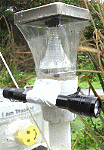 Thursday 13th November:
The timing of the spare SPOT transmissions are now accurate enough, gaining only 1/2 minute each day. This was checked
by watching when both LEDs starting flashing. Power was at 3.61v @ 1030, measured inside the waterproof box, where
the small solar panel plugs in.
The SPOT Management software has also been set up to rename
this spare SPOT as "Spot4" instead of "Snoopy". This is to avoid confusion with "Spot3", that has been running for
almost two years, and is that on Snoopy's boats 9 then 10. The optional emails from it are sent to Robin's spot4@gpss.co.uk
and can be set up to be directed elsewhere. e.g. Spot3 is directed to the Microtransat tracking system.
Tests on the lamps showed that, in these long UK winter nights, that on Snoopy's boat struggles to stay on for
3 hours (e.g. 1640 - 1940). The modified one may have lasted just another hour. An experiment was done with
a small cheap (£6.50) hand torch, with 3 LED and two AA batteries, to see how long it stayed on. The idea was
for it being a "disposable" item, pointing back, from below the navigation light. The practical effect
would be a directional, brighter light, extending range a little, and telling us when the boat was sailing directly away.
It seems the batteries were only enough to keep this bright for one or two hours, before it faded, but it was still on
at 1130, and has been left on.
It might be of little use, unless a launch were late, near dusk, but it's worth considering.
Thursday 13th November:
The timing of the spare SPOT transmissions are now accurate enough, gaining only 1/2 minute each day. This was checked
by watching when both LEDs starting flashing. Power was at 3.61v @ 1030, measured inside the waterproof box, where
the small solar panel plugs in.
The SPOT Management software has also been set up to rename
this spare SPOT as "Spot4" instead of "Snoopy". This is to avoid confusion with "Spot3", that has been running for
almost two years, and is that on Snoopy's boats 9 then 10. The optional emails from it are sent to Robin's spot4@gpss.co.uk
and can be set up to be directed elsewhere. e.g. Spot3 is directed to the Microtransat tracking system.
Tests on the lamps showed that, in these long UK winter nights, that on Snoopy's boat struggles to stay on for
3 hours (e.g. 1640 - 1940). The modified one may have lasted just another hour. An experiment was done with
a small cheap (£6.50) hand torch, with 3 LED and two AA batteries, to see how long it stayed on. The idea was
for it being a "disposable" item, pointing back, from below the navigation light. The practical effect
would be a directional, brighter light, extending range a little, and telling us when the boat was sailing directly away.
It seems the batteries were only enough to keep this bright for one or two hours, before it faded, but it was still on
at 1130, and has been left on.
It might be of little use, unless a launch were late, near dusk, but it's worth considering.
 8pm update:The timer software in TIMESPOTH was updated to put the delay back in it's normal place, BEFORE the transmission.
This means that the battery going flat will appear as delayed transmissions, drawing less, rather than more power from
the batteries. I also used the opportunity to add 1.2 secs to the delay, so it may become even more accurate. Spot4 was restarted
a bit before 1945, but I intend to restart it at exactly 2030, and also do a manual transmission, by use of [OK] button.
Don't worry about that inaccurate report to the west: it happens :-)
The torch still had not gone completely out, so the batteries were swapped for new Maplin alkaline, giving a bright light,
watched by CCTV, and we will see how long that lasts.
8pm update:The timer software in TIMESPOTH was updated to put the delay back in it's normal place, BEFORE the transmission.
This means that the battery going flat will appear as delayed transmissions, drawing less, rather than more power from
the batteries. I also used the opportunity to add 1.2 secs to the delay, so it may become even more accurate. Spot4 was restarted
a bit before 1945, but I intend to restart it at exactly 2030, and also do a manual transmission, by use of [OK] button.
Don't worry about that inaccurate report to the west: it happens :-)
The torch still had not gone completely out, so the batteries were swapped for new Maplin alkaline, giving a bright light,
watched by CCTV, and we will see how long that lasts.
Friday 14th November:
SPOT4 is still accurate to 1/2 minute per day, but now loses instead of gains. The power had dropped to 3.58v by 0800,
and spare Ni-Me cells are ready for John and Dick. I tried use of a mains spotlight, close to the solar panel on the box
- an old trick used years ago on the first GPS Bottles project. This seems to have raised power to 3.59v in two hours.
The 0830 SPOT report failed, because it was deep inside our house, shielded from signals. 0930 was OK, because
the SPOT was put outside. Snoopy's light only lasted an hour, last night, and the modified version even less.
The torch with new Maplin batteries was bright for one or two hours, but had almost completely dimmed after 4 hours.
Not surprising, since - even when it is out - the sun is very low, and often hidden by trees !
2pm update:
Dick now has Spot4, plus spare batteries, etc, ready for the trip with John. During our pub grub break, with the
tracker in Dick's car, we saw some strange behaviour, such as delayed or lost transmissions. Last was at 1153.
Hopefully we will see more soon. 1530 update: Spot4 seems OK - got a 1505 position in Reading.
Saturday 15th November: No Spot4 reports yet, since that one in Reading. Maybe due to buildings shielding signals ? Hopefully we will get more soon.... We have ! This one just came in, timed at 1144, and they are clearly at the boat ! :-) See the Spot4 Position of 1144 Saturday ! Have a safe journey guys ! :-) It is better we do this work on the spare SPOT now, rather than just before we need it in Boat 11, sometime into 2015 ! See the Spot4 Tracking Page. Dick and John borrowed it, so we might track them collecting John's new boat !


 There are few positions, probably due to low power.
Last night I tested a different product as a "disposable light" - the Ronson "3 LED sticky light". CCTV showed it giving a bright,
directional light all night, and it was still on this morning, 17 hours later ! Here is a CCTV picture with a deer
caught on camera, and the light at the bottom of the mast. It runs off three AAA batteries. I've ordered another
three of these lights off Amazon, for just £7.35 delivered tomorrow.
There are few positions, probably due to low power.
Last night I tested a different product as a "disposable light" - the Ronson "3 LED sticky light". CCTV showed it giving a bright,
directional light all night, and it was still on this morning, 17 hours later ! Here is a CCTV picture with a deer
caught on camera, and the light at the bottom of the mast. It runs off three AAA batteries. I've ordered another
three of these lights off Amazon, for just £7.35 delivered tomorrow.
Monday 17th November:
Spot4 not working, probably due to low power, but email shows Dick & John near Lizard at 0730.
The Ronson lights work brilliantly, staying on for days, even when three AAA batteries low.
Very bright for two hours, drawing typically 60mA from 4.7v. Still on, drawing 11mA from 3v.
Brighter, in narrow directional beam, than the 360 degree Ultra lights.
This product is certainly ideal as a "disposable" additional light, for the hours after launch,
to help track boat, and indicate when it is heading directly away.
I visited Bray Lake today, to check
Snoopy's Paint Test: it seems Trilux 33 wins ! :-)
Tuesday 18th November: Dick reported south of Weymouth at 1540. Floating red fishing line arrived - for a "Plan B" launch ?
Amazing to see the Ronson lights are STILL on !
Wednesday 19th November: John and Dick arrive safely at The Hamble !
Robin and friend Richard, go down to collect them, and their junk, in exchange
for a free restaurant meal from John :-) Robin starts the Spot4 tracker again,
by replacing the two NiMe internal batteries by Lithium ones, and reconnecting
the futaba connector on the Picaxe board (poor contact?). We then get transmissions
every hour at 1253, 1351, 1451, but then delayed at 1613, 1723, 1832
- a sign of low power. At home, it was confirmed the Lithiums were now only giving 3.26v,
when normally the SPOT - and Picaxe timer - get 3.6v. Two NiMe cells, each 1.8v, were
put in, and it restarted at 1850.
Today I won yet another "spare" SPOT Messenger 1 on ebay, at £42, to be delivered Monday.
I'll be calling this "Spot5". So in summary: Spot1=lost in 2012 attempt; Spot2=red light fault, unused;
Spot3 in Snoopy's Boat 10; Spot4 under test; Spot5 ordered.
Also, a piece of the red fishing line has been "float tested": it continues to float,
in a bowl of soapy water :-)
Friday 21st November:
Spot4 problem was almost certainly a poor contact of futuba plug - which is normally soldered. Spot4 is still running,
off only the two internal NiMe cells, and no NiMH or solar panel. No delayed transmissions yet (typically at 0953) 3.46v @ 0955,
and 3.51v @ 1030 yesterday. We started with two fresh NiMe cells at about 7pm Wednesday (see above): We will see how long it lasts.
Batteries were 3.45v @ 2200.
Spot4 has now
been running 51 hours off just the internal NiMe cells.
Saturday 22nd November: Spot4 voltage 3.41v @ 1050,
then 3.43v* @ 1600, and still no delays. *Interesting ! Timer 30sec after 1050.
Spot4 has now been running 69 hours off just the internal NiMe cells.
Thursday 27th November:
Amazed to see Spot4 STILL running, without delays: now 7 days 21 hours, on just two internal NiMe cells ! Voltage: 3.39v @ 1715.
Timing also accurate.
Saturday 29th November:
The spare Spot4 STILL running, without delays: now 9 days 17 hours !
Wednesday 3rd December:
Distracted by our attempt last Sunday :-) The spare Spot4 is STILL running, now reporting every 1 1/4 hours. 3.22v.
That's now exactly 14 days, on just internal batteries ! Here are some notes I made on earlier days:
Monday 1st: slower reporting, from every hour, to every 1 1/4 hour, due to voltage dropping to 3.30v @ 2220.
Thursday 11th December: This was posted on the "current"
Blog yesterday.
"
A 6 minute video of Snoopy's last attempt is
here.
Tried pressing the [Help] button on spare Spot4 tracker and was pleasantly surprised that reports
are every 2 or 3 minutes - "until batteries go flat" according to the book. This could be extremely
usefull, as an alternative to modifying the SPOT and oprating the [OK] button with a Picaxe time.
But, we will need to check the policy of SPOT LLC on this: they might consider it abuse of the service.
See
Spot4 Map."
It seems that Spot4 eventually stopped sending reports at 0614 on 5th December. i.e. over 15 days
on just the internal Ni-Me batteries. It seems we may get a lot more from these Spot products
than we have been - but we must be careful not to abuse the service.
Snoopy's Team-Joker got together at Bray Lake with Roger and his "George and Dragon" boat: see below.
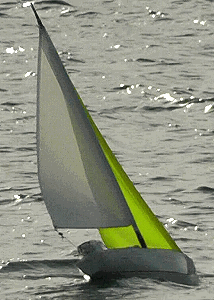
 Friday 12th December:
Checkout the 5 minute
Video of Roger's George & Dragon boat !
Roger is happy for this to appear here, but it is his video, if he wants to tell the Microtransat List or others about it.
Roger has his own Microtransat Team "George and Dragon", intending to attempt the Atlantic, and lives not far away
from us "Team-Joker" guys. We all thought it a good idea to try one of Snoopy's autopilots on Roger's boat,
that he built from Scratch - unlike Robin, who uses standard second-hand Marblehead hulls, filled with foam.
You will see, in the video, our plastic boxes, duck-taped onto the deck, carrying things like the autopilot,
GPS Loggers, and the spare Spot4 tracker. We tried the [Help] button on it, and it sent position reports
every few minutes for an hour. Robin's GPS Logger provided us with the valuable data, every 6 seconds.
Time will tell if we can get the same quality of GPS Plot from the I-GotU, which was also on the deck.
We used the "tried and tested" Autopilot, used in all Snoopy's attempts, and the vast majority of Bray Lake Tests.
The wind was the strongest I remember ever, attempting this test, with wind which must have been 20mph and more.
The result was what we've seen many times, in a strong westerly wind, with the boat failing to turn through
the wind, and change tack, upwind to the waypoint. We have started to experiment with "jibe turn" logic,
on the new 28X2 computer (see above) but we have yet to see it solve this problem in a strong wind.
Even our Boat 11 has the old autopilot fitted, while we check out the basics, like it's sailing balance.
e.g. things like weather helm. I'm confident that Roger's boat will do the Bray Lake test faster than
any of Robin's boats, if it is set up as we saw it yesterday. The whole boat - particularly sails - is
much "cleaner" than Robin's boats, and the only change that might be worth considering for the
neext Bray Lake Test, is putting a boom on the jib, and setting both booms to 30 degrees from centre.
But this is obviously all up to Roger. We don't want to help him too much, and he certainly
cannot have the assistance of Snoopy the Viking :-)
Friday 12th December:
Checkout the 5 minute
Video of Roger's George & Dragon boat !
Roger is happy for this to appear here, but it is his video, if he wants to tell the Microtransat List or others about it.
Roger has his own Microtransat Team "George and Dragon", intending to attempt the Atlantic, and lives not far away
from us "Team-Joker" guys. We all thought it a good idea to try one of Snoopy's autopilots on Roger's boat,
that he built from Scratch - unlike Robin, who uses standard second-hand Marblehead hulls, filled with foam.
You will see, in the video, our plastic boxes, duck-taped onto the deck, carrying things like the autopilot,
GPS Loggers, and the spare Spot4 tracker. We tried the [Help] button on it, and it sent position reports
every few minutes for an hour. Robin's GPS Logger provided us with the valuable data, every 6 seconds.
Time will tell if we can get the same quality of GPS Plot from the I-GotU, which was also on the deck.
We used the "tried and tested" Autopilot, used in all Snoopy's attempts, and the vast majority of Bray Lake Tests.
The wind was the strongest I remember ever, attempting this test, with wind which must have been 20mph and more.
The result was what we've seen many times, in a strong westerly wind, with the boat failing to turn through
the wind, and change tack, upwind to the waypoint. We have started to experiment with "jibe turn" logic,
on the new 28X2 computer (see above) but we have yet to see it solve this problem in a strong wind.
Even our Boat 11 has the old autopilot fitted, while we check out the basics, like it's sailing balance.
e.g. things like weather helm. I'm confident that Roger's boat will do the Bray Lake test faster than
any of Robin's boats, if it is set up as we saw it yesterday. The whole boat - particularly sails - is
much "cleaner" than Robin's boats, and the only change that might be worth considering for the
neext Bray Lake Test, is putting a boom on the jib, and setting both booms to 30 degrees from centre.
But this is obviously all up to Roger. We don't want to help him too much, and he certainly
cannot have the assistance of Snoopy the Viking :-)
Saturday 13th December: For those who want to experiment with data from the I-GotU, this file in CSV format seems to hold good data, but times are +1 hours, because the @TripPC software added an hour for BST. On this date, BST = GMT = UT used by GPS. I used Wordpad to chop out data before launch at 1030 GMT on 30 Dec, and after hitting the rocks late on 2nd Dec. See RBAA14C.CSV.
Thursday 8th January 2015: Yesterday, prompted by the spare Spot4 running longer than expected off just it's internal Ni-Me cells, the current drawn was measured: it was only 27mA, less than the 80mA, during the 15 minute transmission cycle, measured in 2012, with our first SPOT Messenger 1. There could be several reasons for this, including my multimeter, mistakes in 2012, or maybe the Messenger product changed. Maybe we can increase the rate of reporting from every hour, to 30 minutes, or even 20 minutes ? To investigate this further, the Picaxe software timer in SPOTTIMEH.BAS was copied to a new SPOTTIMEI.BAS and the 60 minute delay changed to 20 minutes. Minor changes to the number were then made, to increase accuracy, watching when the timer "presses" the [OK] button. i.e. watching for the double LED flash starting.
Monday 12th January:

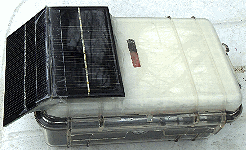 The Spot4, reporting every 20 minutes, had been put outside, on Friday 9th, in the "sunniest" spot, in the old enclosure used for SPOT tests.
This has a small solar panel, but this was always too small to keep the SPOT running, other than perhaps in the summer
- if it is sunny (see left). As expected, the 20 minute reports starting missing, by the early hours of Saturday. However, it was managing
to get about 1 report/hour, until it's last at 1814 on Saturday. This morning, I decided to add a bigger solar panel, but,
saw that the box had fallen off the chair, and was laying face down on the ground (no transmissions could get out, and no
light on the solar panel). This could have happened at any time. It was stood on the chair, facing cloudy sky, at 1020. Voltage was
3.16v at 1030. It will be interesting if it eventually manages to get a report out... results looked very promising indeed:
enough solar power was gathered to re-start Spot4 transmissions at 1141, 1216 and 1252. Voltage had risen to 3.32v by 1200.
A second panel was added, in parallel with the first (see right), at 1315. These panels are not listed (now) on FirstStopSolar,
but I see each is 100x55mm and so probably products claimed to be 6v 100mA. For experimental work like this,
I've just searched ebay then ordered ten 115x70mm panels, claiming 6v 166mA, at total of £20.90, from bestselling365 in China.
The Spot4, reporting every 20 minutes, had been put outside, on Friday 9th, in the "sunniest" spot, in the old enclosure used for SPOT tests.
This has a small solar panel, but this was always too small to keep the SPOT running, other than perhaps in the summer
- if it is sunny (see left). As expected, the 20 minute reports starting missing, by the early hours of Saturday. However, it was managing
to get about 1 report/hour, until it's last at 1814 on Saturday. This morning, I decided to add a bigger solar panel, but,
saw that the box had fallen off the chair, and was laying face down on the ground (no transmissions could get out, and no
light on the solar panel). This could have happened at any time. It was stood on the chair, facing cloudy sky, at 1020. Voltage was
3.16v at 1030. It will be interesting if it eventually manages to get a report out... results looked very promising indeed:
enough solar power was gathered to re-start Spot4 transmissions at 1141, 1216 and 1252. Voltage had risen to 3.32v by 1200.
A second panel was added, in parallel with the first (see right), at 1315. These panels are not listed (now) on FirstStopSolar,
but I see each is 100x55mm and so probably products claimed to be 6v 100mA. For experimental work like this,
I've just searched ebay then ordered ten 115x70mm panels, claiming 6v 166mA, at total of £20.90, from bestselling365 in China.
 Tuesday 13th January:
Today I discovered, via the
Picaxe Forum
that the Picaxe chips used for our autopilot have non-volatile memory.
Details are described on the Picaxe page
EPROM
and linked pages such as DATA, READ, and WRITE. For years I had assumed that we could not
"remember" the current waypoint, so this has to be calculated from GPS lat/lon regularly,
since the boat might have a power failure, but then recover and "reboot" when the sun comes out.
Only 6 bytes are needed for the waypoint destination lat/lon, so this could be the last 6 bytes
of program memory - we normally have that amount free - just :-)
We will need to give use of this method some thought, since we exploit switching the
autopilot off and on, as a means of re-setting the waypoint to the default "Bray Lake Waypoint A".
However, with care, it may enable the boat system to become less vulnerable to temporary power failure.
Some parts of the route, such as the last section to the USA coast, rely on remembering the waypoint.
Excellent advice on the Picaxe Forum thread above, includes "1 year / 7 secs = 4505142 writes, which is well over 100k, so definitely not recommended."
The 7 seconds is the Picaxe Autopilot control loop.
i.e. this EPROM feature might be of use in the future, if used carefully, but - for storing the current waypoint, across
power failures, we would probably do better to use the existing technique, of calculating the destination for
any GPS lat/lon position. Although, in some future "switched power" auopilot, there might be several control loops.
e.g. a slower loop which used this EEPROM feature, and other "navigation", rather than "steering" things like deciding the waypoint.
100,000 cycles, for 1 year -> approx 5 minutes - so still worth consideration - BUT WITH CARE ! :-)
Tuesday 13th January:
Today I discovered, via the
Picaxe Forum
that the Picaxe chips used for our autopilot have non-volatile memory.
Details are described on the Picaxe page
EPROM
and linked pages such as DATA, READ, and WRITE. For years I had assumed that we could not
"remember" the current waypoint, so this has to be calculated from GPS lat/lon regularly,
since the boat might have a power failure, but then recover and "reboot" when the sun comes out.
Only 6 bytes are needed for the waypoint destination lat/lon, so this could be the last 6 bytes
of program memory - we normally have that amount free - just :-)
We will need to give use of this method some thought, since we exploit switching the
autopilot off and on, as a means of re-setting the waypoint to the default "Bray Lake Waypoint A".
However, with care, it may enable the boat system to become less vulnerable to temporary power failure.
Some parts of the route, such as the last section to the USA coast, rely on remembering the waypoint.
Excellent advice on the Picaxe Forum thread above, includes "1 year / 7 secs = 4505142 writes, which is well over 100k, so definitely not recommended."
The 7 seconds is the Picaxe Autopilot control loop.
i.e. this EPROM feature might be of use in the future, if used carefully, but - for storing the current waypoint, across
power failures, we would probably do better to use the existing technique, of calculating the destination for
any GPS lat/lon position. Although, in some future "switched power" auopilot, there might be several control loops.
e.g. a slower loop which used this EEPROM feature, and other "navigation", rather than "steering" things like deciding the waypoint.
100,000 cycles, for 1 year -> approx 5 minutes - so still worth consideration - BUT WITH CARE ! :-)
Wednesday 14th January:
Spot4 managed to transmit a total of 21 reports yesterday, averaging about one every 25 minutes.
The first was at 1032 about 30 minutes after weak, low sunshine hit the box. The last was at 1933,
about 3 hours after it got dark. There was probably less than an hour of sunshine on the box yesterday,
with the low sun being hidden by trees, and cloud. Today it is much sunnier, with a low sun hitting
the box after about 10am. The first Spot4 reports were at 1112,1133,1159,1215,1250 and 1310.
SPOT Power was up to 3.56v at 1320, so Spot4 should stay running until late tonight.
Thursday 15th January:
Spot4 managed to transmit 31 reports yesterday, averaging one every 25 minutes,
the first was at 1112 and the last at 0041 after midnight.
There was a (rare) rogue position, at 2326, on Chobham Common.
This morning, the sun was covered by cloud,
but there are clear patches expected through the day.
The first report today was 1109, and they continued every 20 minutes, until 1630,
when they slowed to every ~ 30 minutes: 1630,1703,1731,1808...
The last report was at 2009, giving a total of 20, averaging every 27 minutes.
Conclusions are that Spot4 can be kept running
on very little solar power, and probably does consume less than 30mA from a 3.6v supply,
if reporting every 20 minutes. Hourly reporting will be even less: ~ 10mA.
Friday 16th January:
Re-charged Ni-Me and Ni-MH batteries were put in the Spot4, and it restarted for first 20 minute reports at 0923,1000,1020. It should continue for days :-)
Saturday 17th January:
Spot4 timing had gained 3 minutes in 25 hours, during a frosty night (temperature dependent?).
2.4 secs was added
in the 20 minute delay, in Picaxe TIMESPOTI.BAS and Spot4 restarted at 1139 plus a manual Tx at 1140.
Target times are at 00,20 and 40 minutes past each hour.... Looking good: 1200,1220,1240,1300,1320,1340 ...
Voltage 3.86v @ 1350 after bright sun.
Tuesday 20th January:
Timer was adjusted to +0.7 sec, since it seemed to gain about 50secs in 24 hours.
Restarted at about 65 secs before 0940.
See the
Spot4 Tracking Page.

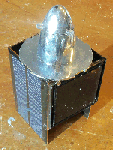 Wednesday 28th January:
Boat10 is practically ready for another attempt, but we are using our last spare of the "Ultra" lamp,
to replace that lost on Portland. The last "Ultra" cost only £2.50, but was taken off the Homebase shelves,
and has not yet reappeared. The "Ultra" product was always a compromise on brightness and how many
hours the lamp stayed on at night. It was decided to experiment with parts from these garden lamps
and extra solar panels. The intention is a new lamp assembly that "plugs in" mechanically to
replace the lamp on the boat. Hopefully we can make a lamp which is both brighter, and stays on
from dusk to dawn, including in winter months. This could be put on Boat10, but could be a better
"product" for future boats, including Boat11, expected to follow Boat10, later in 2015.
Here is our new experimental lamp, taking shape. Electronics from the "bright" product
were removed and soldered together. That's the 3-LED light on the top, and the original 65x65mm
solar panel on the right.
Wednesday 28th January:
Boat10 is practically ready for another attempt, but we are using our last spare of the "Ultra" lamp,
to replace that lost on Portland. The last "Ultra" cost only £2.50, but was taken off the Homebase shelves,
and has not yet reappeared. The "Ultra" product was always a compromise on brightness and how many
hours the lamp stayed on at night. It was decided to experiment with parts from these garden lamps
and extra solar panels. The intention is a new lamp assembly that "plugs in" mechanically to
replace the lamp on the boat. Hopefully we can make a lamp which is both brighter, and stays on
from dusk to dawn, including in winter months. This could be put on Boat10, but could be a better
"product" for future boats, including Boat11, expected to follow Boat10, later in 2015.
Here is our new experimental lamp, taking shape. Electronics from the "bright" product
were removed and soldered together. That's the 3-LED light on the top, and the original 65x65mm
solar panel on the right.
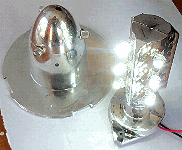 On the left of the picture is one of the three 115x70mm panels, wired through isolation diodes, direct to the
two Maplin 2200mAH AA NiMH cells inside. i.e. the original panel controls the lamp switching on
at night, but the majority of solar power will come from those three new panels: £2.10 each off e-bay,
described as "6v 1w 166mA Solar Panel 115x70mm". This is probably more than capable of powering
more/brighter LEDs. I found the LED assembly from the "Super Bright" product, which has 9 LEDs,
instead of just 3 in the "Bright" product. See the two LED assemblies on the right, with the 9 LEDs ON.
I notice that a bright light is given in all directions, but 6 LED all point in one direction
- a good solution, if pointed to the rear ?
The 3 cell pack was rapid charged at 2A for 15 minutes and, watcheed by CCTV, the SB LEDs, now connected,
instead of the Bright assembly, only lasted 1.5 hours. Not sure of reason yet.
On the left of the picture is one of the three 115x70mm panels, wired through isolation diodes, direct to the
two Maplin 2200mAH AA NiMH cells inside. i.e. the original panel controls the lamp switching on
at night, but the majority of solar power will come from those three new panels: £2.10 each off e-bay,
described as "6v 1w 166mA Solar Panel 115x70mm". This is probably more than capable of powering
more/brighter LEDs. I found the LED assembly from the "Super Bright" product, which has 9 LEDs,
instead of just 3 in the "Bright" product. See the two LED assemblies on the right, with the 9 LEDs ON.
I notice that a bright light is given in all directions, but 6 LED all point in one direction
- a good solution, if pointed to the rear ?
The 3 cell pack was rapid charged at 2A for 15 minutes and, watcheed by CCTV, the SB LEDs, now connected,
instead of the Bright assembly, only lasted 1.5 hours. Not sure of reason yet.
Thursday 29th January:
I was surprised to see that both SB and B LED assemblies draw the same ~ 60mA from 3 cells
(although the B is normally powered by 2 cells). One of those new panels provides s/c current
of 100mA in full sun and nearer 40mA with a low sun angle.
Doing some sums ... If we dispensed with the electronics to switch off the LEDs during the day,
the power drawn in 24 hours (always on) would be 24 x 60mA = about 1500mAH.
If we suppose 4 panels each supply an average of 50mA charging, that's 200mA.
i.e. 1500/200 = 7.5 hours of sun needed. So we probably DO need the electronics.
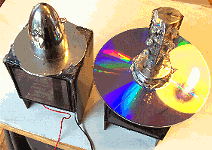 Friday 30th January:
Power tests showed fully charged batteries not lasting as long as expected from the "2000mAH" on the Maplin NiMH cells,
and the ~60mA currents measured by my meter. i.e. instead of lasting > 30 hours, batteries went flat in less than 7 hours.
Tonight, two fully charged prototype lamps will be put on the window sill, watched by CCTV, to see how long each last.
Both include the three new solar panels, and I've duplicated in parallel, the Maplin NiMH cells, to give 4000mAH capacity.
One, based on the "Bright" product, uses the electronics, small solar panel, and equivalent of two NiMH cells in series.
The other, based on the "Super Bright" product, uses it's electronics, a "bright" solar panel, and equivalent of three
cells in series. Note that the original products are sold with green cells from China, marked only "500mAH".
Yes, that is a DVD used as a refector, on the "Super Bright" prototype :-)
Friday 30th January:
Power tests showed fully charged batteries not lasting as long as expected from the "2000mAH" on the Maplin NiMH cells,
and the ~60mA currents measured by my meter. i.e. instead of lasting > 30 hours, batteries went flat in less than 7 hours.
Tonight, two fully charged prototype lamps will be put on the window sill, watched by CCTV, to see how long each last.
Both include the three new solar panels, and I've duplicated in parallel, the Maplin NiMH cells, to give 4000mAH capacity.
One, based on the "Bright" product, uses the electronics, small solar panel, and equivalent of two NiMH cells in series.
The other, based on the "Super Bright" product, uses it's electronics, a "bright" solar panel, and equivalent of three
cells in series. Note that the original products are sold with green cells from China, marked only "500mAH".
Yes, that is a DVD used as a refector, on the "Super Bright" prototype :-)
Three lights on test: at 4pm: "Ultra"(1 cell):1.25v; "Bright"(2 cell):2.77v; "SuperBright"(3 cell):4.02v. We will see how they compare tonight.
Saturday 31st January: The three lights switched on automatically at about 1720.
"Bright" and "SuperBright" lights lasted until dawn (0720 and 0730 ~ 14 hours) but the "Ultra" had stopped by 1920 (2 hours).
The Ultra had not been re-charged, having been outside. This was given a quick charge and the single AAA NiMH cell soldered
into the lamp, which has 3 LED pointing down onto a reflector. These lamps were weighed: 150gm for the Ultra, and 350gm
for the Bright and Superbright. 350gm is about 2% of the total Boat10 weight. All three lights were put outside,
to continue tests, but of the solar panels, in addition to batteries.
Sunday 1st February:
The three lights switched on automatically at dusk, at about 1710.
The "Ultra" light only stayed on < 2 hours. The extra small solar panel was removed, returning it to the standard product
(done last year in this BlogX).
The "Bright" light stayed on all night, lasting 14 hours, and switching off automatically at Dawn, 0720.
The "Super Bright" light lasted only 7 hours, switching off at 0010. There was a problem with it's
electronics: switching on then off again, as one's hand covers the original solar panel; traced to a broken wire.
Changed to just two cells (instead of duplicated three). Put outside to join other two lights on test.
 Monday 2nd February:
The "Superbright" light lasted just 7 hours. Both "Ultra" and "Bright" lasted until dawn, at 0710, giving about 12 hours.
CCTV showed that the "Bright" light dimmed after four hours (~2330) to a similar level as the "Ultra". All three lights
are left in position, to see how their solar panels perform. I was delighted to see that the experimental Spot4 tracker
was still giving reliable reports every 20 minutes. This was despite falling onto the ground after it's chair was blown over
in strong wind, several days ago ! :-)
See
Spot4 Map."
Monday 2nd February:
The "Superbright" light lasted just 7 hours. Both "Ultra" and "Bright" lasted until dawn, at 0710, giving about 12 hours.
CCTV showed that the "Bright" light dimmed after four hours (~2330) to a similar level as the "Ultra". All three lights
are left in position, to see how their solar panels perform. I was delighted to see that the experimental Spot4 tracker
was still giving reliable reports every 20 minutes. This was despite falling onto the ground after it's chair was blown over
in strong wind, several days ago ! :-)
See
Spot4 Map."
Tuesday 3rd February:
Overnight light tests: "Bright" 14 hours, dusk (1715) until dawn (0715); "Ultra" < 1 hour; "Super Bright" (2 cells) ~ 2 hours.
Wednesday 4th February:
Overnight light tests: "Bright" 14 hours, dusk until dawn; "Ultra" 1.5 hours; "Super Bright" (2 cells) 2.75 hours.
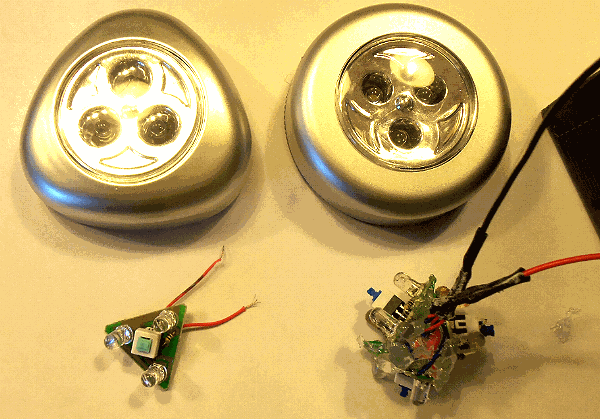 Work has started on what will probably be described as the "Poundland" lamp. Click on the picture on left to see
the larger version. See above, near "Monday 17th November", and below the picture of the harbour.
I was impressed how this "sticky lamp" product performed, with relatively low power consumption.
These are sold under different brand names, but I got the ones used here for £1 for two from Poundland
(i.e. £0.50 each, compared with £2.45 each from Amazon).
The package says "Elektrek", rather than "rolson", but stripping them down, it looks as if they all
come from the same factory - probably in China. I took the small, triangular Printed Circuit Cards, (PCC) from three lamps,
throwing the rest away. Each PCC holds the three LED and an on/off switch.
Work has started on what will probably be described as the "Poundland" lamp. Click on the picture on left to see
the larger version. See above, near "Monday 17th November", and below the picture of the harbour.
I was impressed how this "sticky lamp" product performed, with relatively low power consumption.
These are sold under different brand names, but I got the ones used here for £1 for two from Poundland
(i.e. £0.50 each, compared with £2.45 each from Amazon).
The package says "Elektrek", rather than "rolson", but stripping them down, it looks as if they all
come from the same factory - probably in China. I took the small, triangular Printed Circuit Cards, (PCC) from three lamps,
throwing the rest away. Each PCC holds the three LED and an on/off switch.
 I shorted each switch with solder,
rather than rely on it staying on. The power wires were soldered in parallel. The three cards were then coated in Fastglass resin.
This was a bit "fiddly" to assemble, to point in the three directions, so I ended up using transparent silicon sealant.
This is now soldered in to what was the "Superbright" lamp, replacing what is also a 9-LED assembly.
We returned to the normal 3-cell battery pack. This was put outside before dusk, to join the other two lights on test.
Click on the right photo to see it better: it was taken, with flash, not long after the three lights had switched
on automatically at about 1715.
I shorted each switch with solder,
rather than rely on it staying on. The power wires were soldered in parallel. The three cards were then coated in Fastglass resin.
This was a bit "fiddly" to assemble, to point in the three directions, so I ended up using transparent silicon sealant.
This is now soldered in to what was the "Superbright" lamp, replacing what is also a 9-LED assembly.
We returned to the normal 3-cell battery pack. This was put outside before dusk, to join the other two lights on test.
Click on the right photo to see it better: it was taken, with flash, not long after the three lights had switched
on automatically at about 1715.
Thursday 5th February:
Overnight light tests: "Bright" 14 hours, dusk until dawn; "Ultra" 3.25 hours; "Poundland" 11 hours (until 0415).
Friday 6th February:
Overnight light tests: "Bright" 13.5 hours, dusk until dawn; "Ultra" 1 hour; "Poundland" 2 hours.
Saturday 7th February:
No test because of CCTV failure, losing the video recording.
Sunday 8th February:
Overnight light tests: "Bright" 13.75 hours, dusk until dawn; "Ultra" 1.3 hours; "Poundland" 2.3 hours.
Monday 9th February:
Overnight light tests: "Bright" 13.75 hours, dusk until dawn; "Ultra" 2.5 hours; "Poundland" for 10 minutes
then modified to use "Bright" 3 LED, instead of "Poundland" 9 LED. But still with 3 cells, instead of normal
2 cells for "Bright". Result was it ran very bright, but only lasted 2.75 hours.
Today, one cell was removed, so we now have two "Bright" lights under test.
SOFTWARE: Significant words were put on the "Current"
Blog today, that have significance for future software,
within Boat10 and the Picaxe 28X2 based autopilot.
Here is an extract from the blog entry:
QUOTE:
This autopilot code, after testing, and use in Boat10, will probably find it's way into our Picaxe 28X2 based autopilot,
already tested in Boat11. It is possible (if unlikely) that a mobile 'phone bug and TTS unit is added,
in some future boat, so that anyone can "dial in and listen to Snoopy",
if Snoopy is within mobile 'phone coverage of any shore
(typically 5 to 10 miles, based on our GPS Bottle projects, years ago).
UNQUOTE.
Tuesday 10th February:
Overnight light tests: Both "Bright" 13.5 hours, dusk until dawn; "Ultra" 3 hours.
Wednesday 11th February:
Overnight light tests: Both "Bright" 13.5 hours, dusk until dawn; "Ultra" ~ 1 hour.
Conclusions: Modified "Bright" product, first used in 2012, is still probably the best solution,
including during winter months. The "Ultra" product is probably the best compromise "off the shelf",
but struggles to stay on in long winter nights.
SOFTWARE: Improvements have been made recently in the autopilot software,
still being squeezed into the old Picaxe 08M based autopilot.
When it is finalised, it will be used in Boat10, for the next Atlantic Attempt.
Major parts of this 08M2 software will also be imported into the "experimental" 28X2 software for Boat11.
See the Blog link below.
Saturday 14th February 2015:
Light Test: Ultra off after 30 minutes, but even "Bright" lights struggling in dull weather: 1.75 and 1.25 hours.
But checkout the
Deer Video :-)
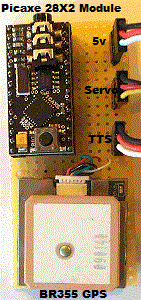 Tuesday 17th February:
Boat10, being prepared for the next Atlantic Attempt, has had it's Picaxe 08M2 based autopilot software improved,
including the UK-USA routing logic and accuracy of direction calculation. This is reported in the "current"
Blog.
Experimental work on the software will continue, in parallel, and be reported here in BlogX.
The RINGRIGX software rig was modified to check direction calculation errors for code on a Picaxe 28X2,
which can use COS and ATAN, and this confirmed errors could be reduced to close to zero.
A Picaxe 28X2 has been ordered, at £15, including First Class Post, and, as a first step,
we will move the current AUTOP9TTS.BAS autopilot across, as a 28X2 based GPS-Only autopilot.
i.e. an intermediate solution between our latest 08M2 autopilot, and the experimental 28X2 based one,
tested last year, that includes a compass, and sensor power switching.
Tuesday 17th February:
Boat10, being prepared for the next Atlantic Attempt, has had it's Picaxe 08M2 based autopilot software improved,
including the UK-USA routing logic and accuracy of direction calculation. This is reported in the "current"
Blog.
Experimental work on the software will continue, in parallel, and be reported here in BlogX.
The RINGRIGX software rig was modified to check direction calculation errors for code on a Picaxe 28X2,
which can use COS and ATAN, and this confirmed errors could be reduced to close to zero.
A Picaxe 28X2 has been ordered, at £15, including First Class Post, and, as a first step,
we will move the current AUTOP9TTS.BAS autopilot across, as a 28X2 based GPS-Only autopilot.
i.e. an intermediate solution between our latest 08M2 autopilot, and the experimental 28X2 based one,
tested last year, that includes a compass, and sensor power switching.
Thursday 19th February: On the right is the prototype autopilot hardware, based on the 28X2 Module and the insides of a Globalsat BR355 GPS. The wiring on the back is certainly not tidy, but it worked first time, after loading the autopilot software with only one statement changed: that saying the code was for a 28X2 instead of a 08M2. There was immediately 2K program memory free, instead of typically 10 bytes ! The new program, AP28X2.BAS was copied from AUTOP9TTS.BAS, to be used by Boat10 in the next Atlantic attempt. This 28X2 based "GPS-Only" autopilot, may become our next "production" autopilot hardware, not to be confused with our experimental versions developed in 2014, including use of a compass, power switching, and a wind sensor. The main development "work" now is moving some of this "experimental" code across, to exploit the extra memory and maths library of the 28X2.
Saturday 21st February: We have three Picaxe autopilot programs:
 I noticed that both Spot3 (on Bray Lake) and Spot4 (in the garden) were not showing recent reports. It turned out
this was for very different reasons: for Spot3, I discovered that recent positions had been "hidden" and so I quickly
"unhid" them. This may have been Spot Support investigating my earlier report (on Blog page). Spot4 was simpler:
strong wind yesterday had knocked it off the garden chair, and it was upside down ! :-) Power was down to 3.24v,
from 3.6v, and we had a red flashing LED. It should recover, after it gets enough sun.
I noticed that both Spot3 (on Bray Lake) and Spot4 (in the garden) were not showing recent reports. It turned out
this was for very different reasons: for Spot3, I discovered that recent positions had been "hidden" and so I quickly
"unhid" them. This may have been Spot Support investigating my earlier report (on Blog page). Spot4 was simpler:
strong wind yesterday had knocked it off the garden chair, and it was upside down ! :-) Power was down to 3.24v,
from 3.6v, and we had a red flashing LED. It should recover, after it gets enough sun.
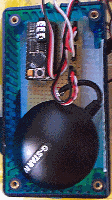 Wednesday 25th February:
Spot4 stopped at 9pm last night, but started OK, with daylight, at 1035am. Boat6 now has the new 28X2 autopilot, ready to test ;-)
Wednesday 25th February:
Spot4 stopped at 9pm last night, but started OK, with daylight, at 1035am. Boat6 now has the new 28X2 autopilot, ready to test ;-)
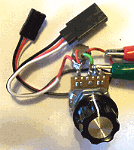 Saturday 28th February 2015:
On the left is a little variable 5v supply, built to investigate behaviour of both 08M2 and 28X2 autopilots,
as power drops, due to days of overcast conditions, then recovers when the sun comes out.
It was built from a 10k potentiometer and a power transistor as emitter-follower. Power comes in from
the usual 5v battery, and leaves on the same type of Futaba connector, into the autopilot.
We got similar, good results, from first tests with both the existing 08M2-BR355 autopilot,
and with the new 28X2-BR355-S4. Tests were done with the TTS unit connected, and this also ran down to the lower voltages.
When fully charged, the solar power system normally provides over 5.1v into the autopilot.
It seems the Picaxe autopilot software and BR355 GPS were still running when the power was lowered to about 3v.
If lowered to about 2v, the software restarted as power is restored, as we would hope. We did see "hunting" of the servo,
below about 4v to 4.5v, but this may have been due to the limitations of this variable supply.
Behaviour seen over the years, includes the autopilot restarting, as it should, after temporary power failure.
Another symptom, not yet re-created, is the servo creeping clockwise (right rudder), under low voltage conditions.
Saturday 28th February 2015:
On the left is a little variable 5v supply, built to investigate behaviour of both 08M2 and 28X2 autopilots,
as power drops, due to days of overcast conditions, then recovers when the sun comes out.
It was built from a 10k potentiometer and a power transistor as emitter-follower. Power comes in from
the usual 5v battery, and leaves on the same type of Futaba connector, into the autopilot.
We got similar, good results, from first tests with both the existing 08M2-BR355 autopilot,
and with the new 28X2-BR355-S4. Tests were done with the TTS unit connected, and this also ran down to the lower voltages.
When fully charged, the solar power system normally provides over 5.1v into the autopilot.
It seems the Picaxe autopilot software and BR355 GPS were still running when the power was lowered to about 3v.
If lowered to about 2v, the software restarted as power is restored, as we would hope. We did see "hunting" of the servo,
below about 4v to 4.5v, but this may have been due to the limitations of this variable supply.
Behaviour seen over the years, includes the autopilot restarting, as it should, after temporary power failure.
Another symptom, not yet re-created, is the servo creeping clockwise (right rudder), under low voltage conditions.
Sunday 1st March 2015:
This variable voltage testing of the 08M2/BR355 autopilot has become important in making Boat10 ready for the next Atlantic Attempt.
Today 4,700uF capacitors were purchased from Maplins and one was sufficient to stop servo "hunting", and start tests,
to try and recreate the problem of the autopilot not restarting when 5v power is slowly restored in morning sunlight.
So far, we've not recreated the problem. Less than 4v is enough for the autopilot to function, including it's Picaxe 08M2 computer,
BR355 GPS, and Acoms As-17 rudder servo. Power was lowered to 3.6v, 3.25v, 2.5v, 1.5v, and 0.66v, then slowly increased to 4v.
Every time, the autopilot re-started and functioned OK. Re-creating the problem, of the autopilot failing to re-start,
may not be easy, since the problem may only occur after some minutes
running at a particular low supply voltage.
Another two 4700uF capacitors were added, and we can now re-create a low power symptom seen for years:
the servo turns fully clockwise (hard right rudder) if the supply voltage is increased slowly from < 1v
to 2.25v. At 3.25v the servo returns to centre, and at 3.6v, the total autopilot system runs, including the TTS.
The autopilot was left running, at 3.6v, at 1600, to see if a failure will occur. i.e. "freezing" of the autopilot.
Tuesday 3rd March:
Unable to recreate "freezing" yet. At 0815, tea-tray power had fallen to 1.18v. Needed to change battery to increase: restarted OK.
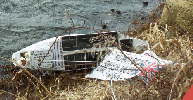 Tuesday 3rd March: This just added to the
Blog page:
Tuesday 3rd March: This just added to the
Blog page:
DIAGNOSIS OF "FROZEN AUTOPILOT" PROBLEM ? It was only today, and after repeated failure to re-create that "frozen autopilot",
reported in this Blog last Friday and Sunday, that I woke up to the likely cause of the problem: poor GPS reception due to
the situation of the boat: leaning over, and in a position where GPS signals could be screened. Last Friday's blog entry
mentions those large ~90m SPOT GPS errors, with the boat near the drain. Look at that picture from Friday, with the boat
leaning over, beached. I've just put up that picture from yesterday, on the right, showing where the boat was when
I found it, after the rescue. If, on either occasion, I had simply lifted the boat into a better position for GPS reception,
and waited a minute or two, that autopilot would probably have started moving the rudder again !
Yes, this has been re-created in our "tea-tray" system - with the GPS wrapped in Bacofoil :-)
The autopilot stops, with whatever "rudder trim" it had at the time. e.g. slightly right.
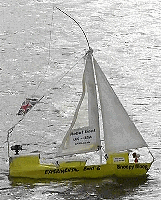
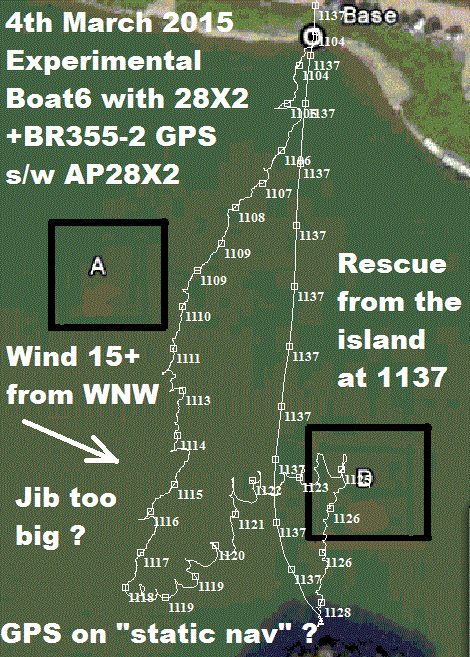 Wednesday 4th March:
While Boat10 continues 24/7 reliability tests on Bray Lake, waiting for our Atlantic launch "weather window", we can
continue experimental work, leading to different hardware for Boat11. Today was the first Bray Lake Test of the new
Picaxe 28X2 / BR355-S4 based autopilot, with the new AP28X2.BAS software. Wind was strong, at 15mph+ from WNW, and
so the normal IOM #3 storm sails would probably have been too big for little Boat6 - our experimental boat.
The smaller sails were always a bit stiff, and I replaced the jib by a larger one, made from a white dustbin bag
and duck tape. It seemed a "good idea at the time", but the result seems to have been Lee Helm, with the boat
failing to turn onto the first waypoint. Click on the GPS Plot to read the details.
Wednesday 4th March:
While Boat10 continues 24/7 reliability tests on Bray Lake, waiting for our Atlantic launch "weather window", we can
continue experimental work, leading to different hardware for Boat11. Today was the first Bray Lake Test of the new
Picaxe 28X2 / BR355-S4 based autopilot, with the new AP28X2.BAS software. Wind was strong, at 15mph+ from WNW, and
so the normal IOM #3 storm sails would probably have been too big for little Boat6 - our experimental boat.
The smaller sails were always a bit stiff, and I replaced the jib by a larger one, made from a white dustbin bag
and duck tape. It seemed a "good idea at the time", but the result seems to have been Lee Helm, with the boat
failing to turn onto the first waypoint. Click on the GPS Plot to read the details.
The Mobius video camera could just about "hear" the TTS speech, from the small box in the middle, and playing back video showed suspicious reporting of the same boat GPS "Course 173" which may be showing a problem at slow speed with this BR355-S4 GPS. Our GPS plot data is of little help, since the GPS logger uses a different GPS. Tea tray tests, with the same autopilot, showed no problem when walking at a normal speed, but - sure enough - if moving very slowly, at maybe 0.2 to 0.5 mph, the direction of movement did not change, and was wrong. The cause could easily be something like "Static Nav" inside the BR355-S4 GPS needing to be switched off. This needs to be investigated, before switching over to what appears to be a better, later model, of Globalsat BR355 GPS receiver. I'm hoping we can use a utility program, SirfDEMO, to switch off static nav, and that it will remain switched off.
 Thanks to Cezar in Romania, I ordered a different servo, as a possible long term replacement of our trusty Acoms AS-17,
used in all our robot boats. The HS-17 was chosen years ago, because of it's average low power consumption of typically 10mA.
They have also proved to be extremely reliable - if protected from water !
The new Hitec HS-5086WP claims even lower power consumption, and looks better "on paper". e.g. metal gears and IP67
waterproof. One arrived today, and here is a photo of it beside an AS-17. It's a lot smaller, and it turns in the
opposite direction to all the other servos I've tried: an inconvenience, but not a "show stopper".
I tried to compare the power consumption, with what could have been an easy test: a 5v battery connected only to the
servo, via a meter on milliamps. No problem with the HS-17: 5mA. Then I tried the same test on the 5086: 10mA
but fluctuating - probably due to it's digital electronics and the effect of it being supplied via the meter ?
The meter was not digital, but of the old moving-coil type.
The most important test is
reliability, and the new servo is now running 24/7, with a Picaxe test program driving both the HS-5086WP and AS-17 in parallel.
The program repeats the "centre-full left-full right-centre" wiggle at about 24 times a minute, so a month of this,
is probably equivalent to several months of our normal autopilot use, with a steering cycle lasting 7 seconds.
If we find this servo IS better, particularly reliability, we MAY switch over to using it - despite the higher
cost of typically £36 compared with £6 for the AS-17. We must also remember to compare specifications,
such as maximum torque, since the AS-17 is clearly bigger, so even it's plastic gears may cope better to "rough and tumble".
Yes, I ordered another two AS-17 today, for spares :-)
Footnote added Monday 9th March: I can now confirm that the HS-5086WP servo DOES draw less power. My problems were probably
due to use of my milliameter: I measured 45 millivolts through a 10 ohm series resistor, indicating 4.5mA into BOTH
the servo AND the Picaxe, which draws about 1mA. This was with the Picaxe providing servo pulses for a fixed (central) servo position.
The same "resistor mV test", with only the servo, and no source of pulses, gave the fluctuating current seen earlier,
of about 10mA, fluctuating between 9mA and 13mA. It seems this servo does what it says in the
HS-5086WP Specification (see advanced specs), and only draws 3mA idle current.
Thanks Cezar :-)
Thanks to Cezar in Romania, I ordered a different servo, as a possible long term replacement of our trusty Acoms AS-17,
used in all our robot boats. The HS-17 was chosen years ago, because of it's average low power consumption of typically 10mA.
They have also proved to be extremely reliable - if protected from water !
The new Hitec HS-5086WP claims even lower power consumption, and looks better "on paper". e.g. metal gears and IP67
waterproof. One arrived today, and here is a photo of it beside an AS-17. It's a lot smaller, and it turns in the
opposite direction to all the other servos I've tried: an inconvenience, but not a "show stopper".
I tried to compare the power consumption, with what could have been an easy test: a 5v battery connected only to the
servo, via a meter on milliamps. No problem with the HS-17: 5mA. Then I tried the same test on the 5086: 10mA
but fluctuating - probably due to it's digital electronics and the effect of it being supplied via the meter ?
The meter was not digital, but of the old moving-coil type.
The most important test is
reliability, and the new servo is now running 24/7, with a Picaxe test program driving both the HS-5086WP and AS-17 in parallel.
The program repeats the "centre-full left-full right-centre" wiggle at about 24 times a minute, so a month of this,
is probably equivalent to several months of our normal autopilot use, with a steering cycle lasting 7 seconds.
If we find this servo IS better, particularly reliability, we MAY switch over to using it - despite the higher
cost of typically £36 compared with £6 for the AS-17. We must also remember to compare specifications,
such as maximum torque, since the AS-17 is clearly bigger, so even it's plastic gears may cope better to "rough and tumble".
Yes, I ordered another two AS-17 today, for spares :-)
Footnote added Monday 9th March: I can now confirm that the HS-5086WP servo DOES draw less power. My problems were probably
due to use of my milliameter: I measured 45 millivolts through a 10 ohm series resistor, indicating 4.5mA into BOTH
the servo AND the Picaxe, which draws about 1mA. This was with the Picaxe providing servo pulses for a fixed (central) servo position.
The same "resistor mV test", with only the servo, and no source of pulses, gave the fluctuating current seen earlier,
of about 10mA, fluctuating between 9mA and 13mA. It seems this servo does what it says in the
HS-5086WP Specification (see advanced specs), and only draws 3mA idle current.
Thanks Cezar :-)
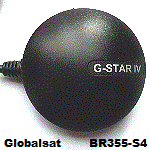
 Thursday 5th March:
Today I wired up a PC cable, so that the BR355-S4 (G-Star IV) GPS could be tested and configured with SirfDEMO, running on the PC.
It could also be tested with my GPSS running on the Laptop, to confirm things like wiring pins correctly. Two wires are enough to receive
GPS data into a PC: see pinouts on right: 0v in black on Pin5, and data from the GPS onto Pin2 (the brown wire on the serial
cable I used). To use SirfDEMO, that sends data to configure the GPS, the third (red) wire was used, on Pin3. It was possible that
this particular GPS, which shows problems of not giving good direction of movement at low speeds (seen yesterday), was one that
I was experimenting with last year. e.g. using SirfDEMO to put into power saving mode. When running GPSS and displaying the
raw $GPRMC data from the GPS, I immediately saw a suspicious symptom: zero velocity and direction not changing. Most GPS,
if not in static navigation mode, tend, when stationary, to output a random direction, and a non-zero speed, reflecting
their inaccuracy. Above about 0.1 to 0.2 mph, the accuracy of direction can generally be relied upon for steering the boat.
SirfDEMO was used to send "Static Nav OFF", but no change was seen. Then SirfDEMO was used to do a "factory reset", and
it seems that we do now see random directions when stationary. However, by the time I had unsoldered the cable from the Picaxe board,
tea-tray tests outside showed the same symptoms of direction not changing, and being correct, at low speeds of ~ 0.5 mph.
Thursday 5th March:
Today I wired up a PC cable, so that the BR355-S4 (G-Star IV) GPS could be tested and configured with SirfDEMO, running on the PC.
It could also be tested with my GPSS running on the Laptop, to confirm things like wiring pins correctly. Two wires are enough to receive
GPS data into a PC: see pinouts on right: 0v in black on Pin5, and data from the GPS onto Pin2 (the brown wire on the serial
cable I used). To use SirfDEMO, that sends data to configure the GPS, the third (red) wire was used, on Pin3. It was possible that
this particular GPS, which shows problems of not giving good direction of movement at low speeds (seen yesterday), was one that
I was experimenting with last year. e.g. using SirfDEMO to put into power saving mode. When running GPSS and displaying the
raw $GPRMC data from the GPS, I immediately saw a suspicious symptom: zero velocity and direction not changing. Most GPS,
if not in static navigation mode, tend, when stationary, to output a random direction, and a non-zero speed, reflecting
their inaccuracy. Above about 0.1 to 0.2 mph, the accuracy of direction can generally be relied upon for steering the boat.
SirfDEMO was used to send "Static Nav OFF", but no change was seen. Then SirfDEMO was used to do a "factory reset", and
it seems that we do now see random directions when stationary. However, by the time I had unsoldered the cable from the Picaxe board,
tea-tray tests outside showed the same symptoms of direction not changing, and being correct, at low speeds of ~ 0.5 mph.
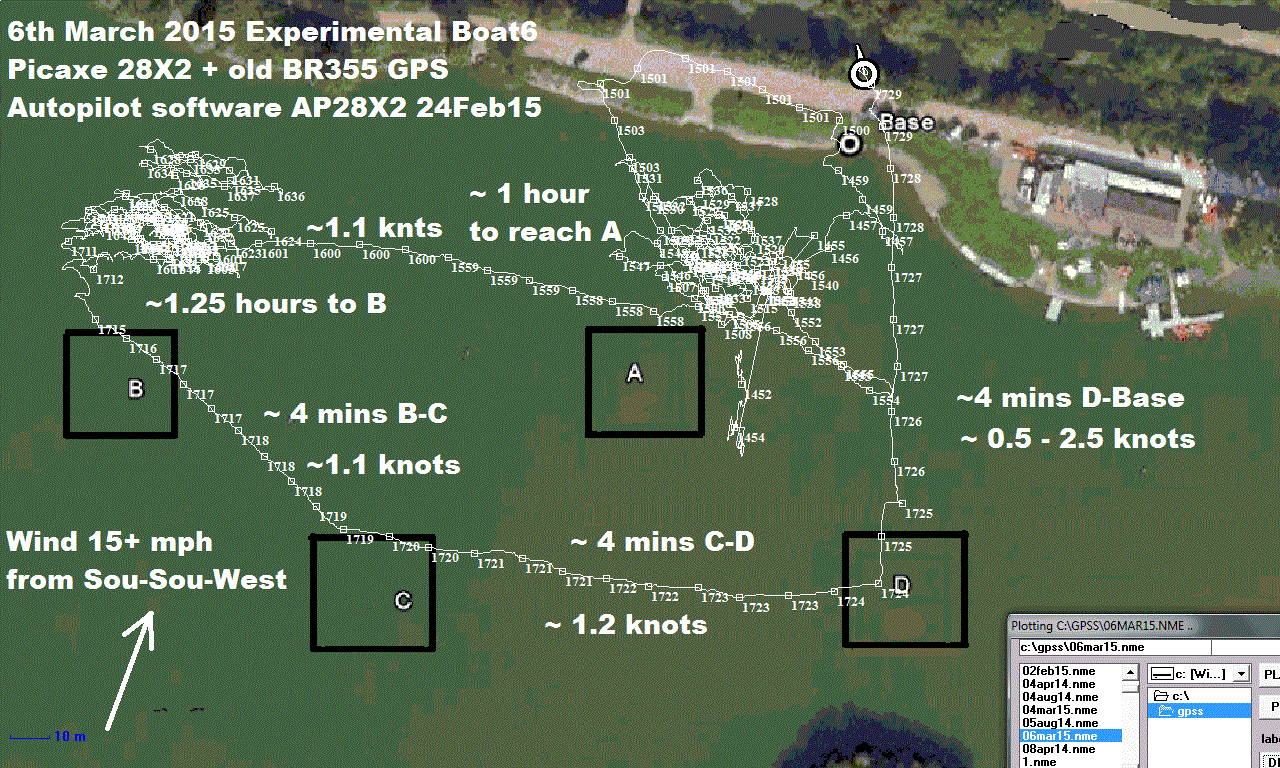
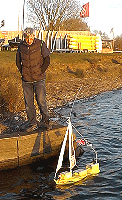 Update at 1945:
Everything works perfectly with the old BR355, instead of the later BR355-S4 (G-SatIV). Luckily I found one of the experimental
28X2 systems from last year, and I loaded this latest AP28X2 software, which does not use the compass, even though there is one
present. Immediately the speech revealed what we should hear: random directions when static. The tea-tray test confirmed
that it worked well: giving the correct direction, when walking slowly, down to ~0.2 mph. This autopilot is now in Boat6,
ready to do a test on Bray Lake.
Update at 1945:
Everything works perfectly with the old BR355, instead of the later BR355-S4 (G-SatIV). Luckily I found one of the experimental
28X2 systems from last year, and I loaded this latest AP28X2 software, which does not use the compass, even though there is one
present. Immediately the speech revealed what we should hear: random directions when static. The tea-tray test confirmed
that it worked well: giving the correct direction, when walking slowly, down to ~0.2 mph. This autopilot is now in Boat6,
ready to do a test on Bray Lake.
Friday 6th March: The Bray Lake Test confirmed that the problem had been due to the new BR355-S4 giving bad direction of movement at low speed: the old BR355 GPS worked as it should. Our only problem was the strong wind of 15mph+ from the SSW, meant that Boat6 had a real struggle making progress upwind to waypoint A and then waypoint B. Click on the GPS Plot on the left to read the details. When the boat did eventually reach waypoint B, the return was fast and accurate - sailing into the target Base drain inlet.
Sunday 8th March:
I just added this link to the current Blog: it looks very useful to see if Snoopy's wandering is due to lack of wind.
Local Wind Speed here.
Thanks Neil :-)
Monday 9th March: footnote added to words about HS-5086WP servo last Wednesday: it DOES need less current. Both servos are still on 24/7 test at home.

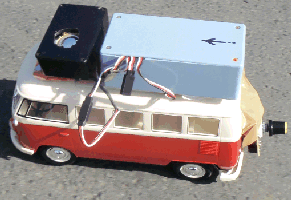 Testing the directional accuracy of GPS such as the BR355-S4 (after a firmware change?) raised the possability of some kind of "test track".
It seems enough length of model railway track (30 yards?) is above my budget - but how about a low cost (£20) radio control toy,
like this VW camper-van that I just got from Maplins ? Use a length of string, or a wooden rail to make it go in a straight line ?
Sadly, more work is needed on it's speed control: either stopped... or very fast ! :-(
Testing the directional accuracy of GPS such as the BR355-S4 (after a firmware change?) raised the possability of some kind of "test track".
It seems enough length of model railway track (30 yards?) is above my budget - but how about a low cost (£20) radio control toy,
like this VW camper-van that I just got from Maplins ? Use a length of string, or a wooden rail to make it go in a straight line ?
Sadly, more work is needed on it's speed control: either stopped... or very fast ! :-(
Thursday 12th March:
Today, after a visit to Bray Lake, to push Snoopy back out on 24/7, I popped into Maplins and picked up
a speed controller (MFA Como drills Part No 919D2P). I thought I might wire it in the path of the electric motor,
but that didn't work, probably because the VW r/c was digital. However, I did wire it directly to the power switch,
under the bus, and it (just about) works. Here, on the right, is it on the road, outside my house, carrying the
speaking autopilot, held on by duck tape. The speed controller, at the back, is held on by parcel tape.
Two problems: it goes faster downhill than uphill, and tends to turn left !
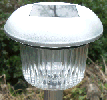 Saturday 14th March: from the "current" Blog...
On the left is one of the four B&Q garden lights, purchased today at £2.50 each. Enquiries at Guardman, maker of the
Cole & Bright "Ultra" product revealed that the "ultra" product, is no longer available, and the new products use glass,
instead of plastic, so would be too heavy. It should not be too difficult to fit this new light, where the earlier
"ultra" one was, on the post, at the back of the boat.
The last of our "ultra" lamps was lost on Bray Lake, during 24/7 testing. Before that, one was lost at sea,
probably when Snoopy hit rocks near Portland. The navigation light is not essential, but we may as well have one,
at the princely sum of £2.50 :-)
Saturday 14th March: from the "current" Blog...
On the left is one of the four B&Q garden lights, purchased today at £2.50 each. Enquiries at Guardman, maker of the
Cole & Bright "Ultra" product revealed that the "ultra" product, is no longer available, and the new products use glass,
instead of plastic, so would be too heavy. It should not be too difficult to fit this new light, where the earlier
"ultra" one was, on the post, at the back of the boat.
The last of our "ultra" lamps was lost on Bray Lake, during 24/7 testing. Before that, one was lost at sea,
probably when Snoopy hit rocks near Portland. The navigation light is not essential, but we may as well have one,
at the princely sum of £2.50 :-)
Sunday 15th March:
All four B&Q lights stayed on all night, dusk until dawn. i.e. ~ 12 hours. With original batteries.
 Tuesday 17th March:
Our 24/7 reliability test of the new Hitec HS-5086WP servo continues, but yesterdasy, the old, trusty Acoms AS-17 servo failed.
It had stopped moving, the casing was very hot, and after unplugging, the mechanism seemed to be locked solid.
Stripping it down did not reveal any obvious fault, such as in the gears. I have no record of how much use this particular
servo has had, but it does set a mimimum standard for our test. The BlogX above shows that this test started on 4th March,
so it had been running for over 12 days.
The test of 24 cycles / minute is perhaps 2.5 times the normal 7 second steering loop, so 12 days is probably equivalent
to about 30 days, or a month of typical continuous use. A brand new AS-17 servo is now connected, so we can see how long this,
and the Hitec servo, survive.
I've ordered another HS-5086WP via ebay, and this time it only cost £24 delivered (3 days), compared with £36 on 2nd March.
This is for Boat11.
Tuesday 17th March:
Our 24/7 reliability test of the new Hitec HS-5086WP servo continues, but yesterdasy, the old, trusty Acoms AS-17 servo failed.
It had stopped moving, the casing was very hot, and after unplugging, the mechanism seemed to be locked solid.
Stripping it down did not reveal any obvious fault, such as in the gears. I have no record of how much use this particular
servo has had, but it does set a mimimum standard for our test. The BlogX above shows that this test started on 4th March,
so it had been running for over 12 days.
The test of 24 cycles / minute is perhaps 2.5 times the normal 7 second steering loop, so 12 days is probably equivalent
to about 30 days, or a month of typical continuous use. A brand new AS-17 servo is now connected, so we can see how long this,
and the Hitec servo, survive.
I've ordered another HS-5086WP via ebay, and this time it only cost £24 delivered (3 days), compared with £36 on 2nd March.
This is for Boat11.
 Saturday 21st March: the last few days have been busy, after the launch on Wednesday of Snoopy's
March 2015 attempt on the Atlantic.
However, today I got the time to try a firmware patch sent by the very helpfull Jesse, at Globalsat in USA.
It went very well indeed, only taking a few minutes to install the firmware patch and then test it
- including after powering the updated BR355-S4 off and back on. Now it does what I want - gives random directions
when stationary, and what seem to be accurate direction of movement when moving very slowly, at down to 0.2 knots or less.
I'll do some more "tea-tray" tests, and we will try it out on Bray Lake, in Boat6, soon.
To ensure we do not lose the patch, I'm sure Globalsat will not mind my hosting it here as
RBPATCH.ZIP. After testing, it will probably be loaded into all my BR355-S4 here.
Saturday 21st March: the last few days have been busy, after the launch on Wednesday of Snoopy's
March 2015 attempt on the Atlantic.
However, today I got the time to try a firmware patch sent by the very helpfull Jesse, at Globalsat in USA.
It went very well indeed, only taking a few minutes to install the firmware patch and then test it
- including after powering the updated BR355-S4 off and back on. Now it does what I want - gives random directions
when stationary, and what seem to be accurate direction of movement when moving very slowly, at down to 0.2 knots or less.
I'll do some more "tea-tray" tests, and we will try it out on Bray Lake, in Boat6, soon.
To ensure we do not lose the patch, I'm sure Globalsat will not mind my hosting it here as
RBPATCH.ZIP. After testing, it will probably be loaded into all my BR355-S4 here.
See Blog page for details of Snoopy's preperation for an attempt on The Atlantic.

Tuesday 24th March: You may have come here from the page with detail of Snoopy's March 2015 Atlantic Attempt .... etc.
The Experimental Blog continues in BlogX.
© 1991-2016 Robin Lovelock. Please credit www.gpss.co.uk if you use material from any of these pages. Thankyou.